How to Integrate Keyword Research Into Your Customer Journey Map
by Greg Mischio | Search Engine Optimization

Creating a Customer Journey map is about more than just understanding your customer’s buying process. It’s also a great way to frame your keyword research, and prioritize the most important content for search engine optimization.
A Customer Journey is tough for most companies, as they usually can’t get past their own product. When it comes to doing keyword research, they focus only on the topics germane to their product or specific solution.
You need that product focus — absolutely. And you must rank #1 for the keywords most often searched to find it. But many customers don’t know you, your product, or perhaps even that the solution you are offering exists.
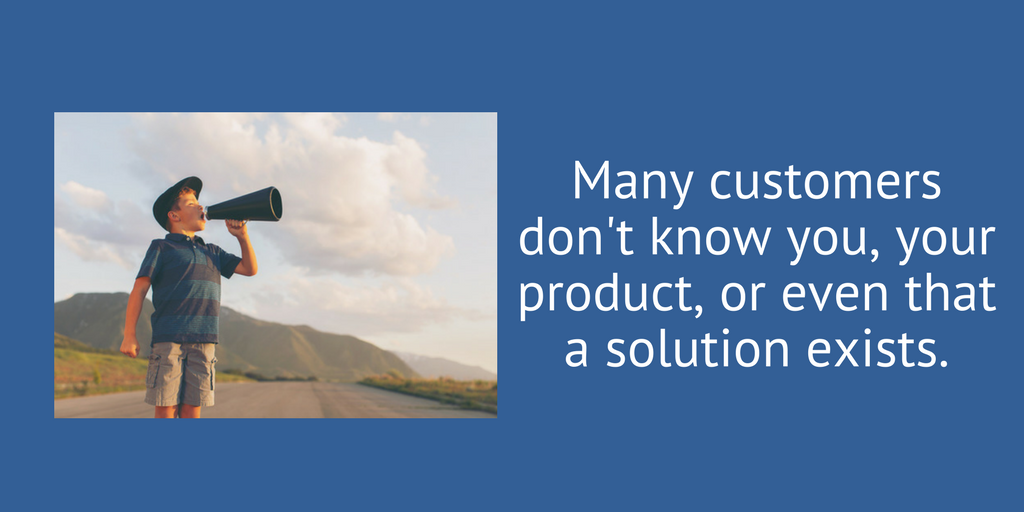
The relationship between you and your customers is a spectrum. You and your product sit on one end, the customer is on the other. The disciplined act of mapping out the steps in between is what can help bridge the gap, exposing you to a much larger audience in the process.

What is Customer Journey mapping?
Customer Journey mapping is the process of identifying the different stages in a customer’s buying cycle — from little or no awareness, to identifying both a problem and a solution, and finally to the purchase and implementation.

Creating a systematic process for mapping the Customer Journey improves your awareness of how your customers think. It also provides a framework for the vast and typically overwhelming world of keywords relevant to your product or service.
Many Customer Journey mapping templates and tools exist. We’re going to explain our approach, which takes you from broad-based topics down to specific keywords.
Customer Journey maps and buyer personas
Before we deep-dive into the process, let’s identify the most important part of this entire exercise: creating an accurate, research-based customer persona.
Anyone who has embarked on content marketing knows the importance of creating a customer persona. You need to create a persona of your ideal customer, and document the qualitative lifestyle habits that will trigger content ideas.

I don’t disagree with this in the least. The problem — and where we’ve misstepped ourselves in the past — is assuming you can write these personas without conducting some type of research and actually talking (via survey, focus group or one-on-one interview) with actual people.
How we biffed in our own Customer Journey mapping process
Our company, Winbound, provides content marketing and conversion optimization services for small marketing departments. It’s a unique, all-in-one service, specifically designed for small marketing departments.
When we first created our persona for directors of small marketing departments, I assumed they’d considered content marketing as part of their overall strategy. Yet when I interviewed a number of them, they didn’t even mention content marketing.
Their challenges were in a variety of different areas — many of which I knew could be solved by effective content marketing. If I was going to reach them, however, I needed to discuss the issues that were most pressing to them, and meet them at the first stage of the Customer Journey.
The bottom line: Don’t proceed to the Customer Journey mapping process when you’ve created a buyer persona using only your own input. You’re too biased. As noted in this great post on Conversion XL :
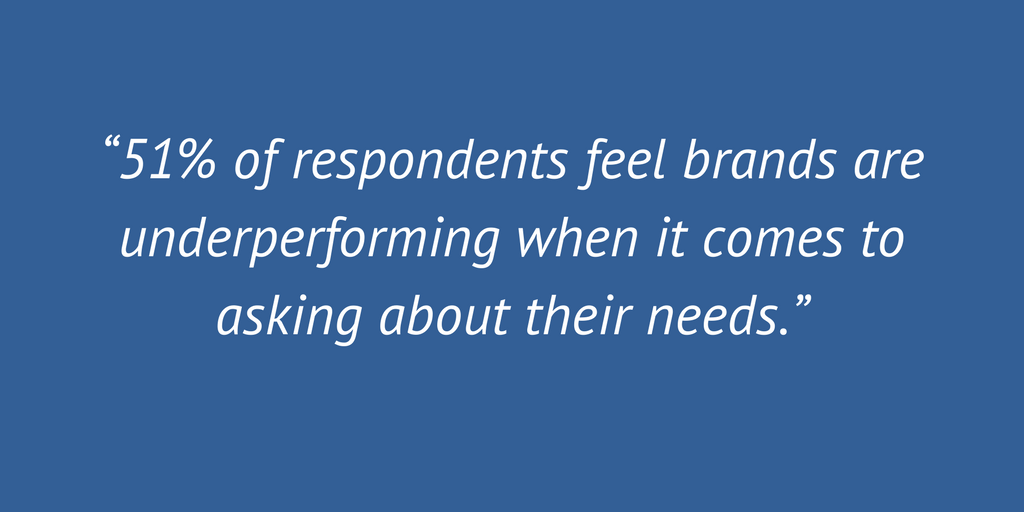
Use a Customer Journey map template
Once you have your buyer persona researched and created, it’s time to move on to the Customer Journey mapping process.
Any Internet search will reveal a boatload of Customer Journey maps. We’ve pulled from many of those to create our own, which is illustrated here:
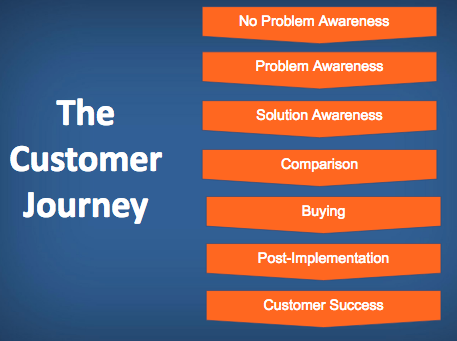
Now let’s take a look at each stage of the Customer Journey. At each stage, we’ll include:
- An explanation of the stage
- Example keywords and content
- Goals and metrics
We will base this Customer Journey on the following product: Bob’s Shark Repellent . Our persona is Helicopter Parents of Young Children .
Customer Journey Stage 1: No Problem Awareness
Explanation:.
At the beginning of the Customer Journey, the customer usually doesn’t even know you exist. Why should they? They’re busy, wrapped up in their own lives and jobs — especially the helicopter parents (aka doting parents) of young children.
Parents at the No Problem Awareness stage are not even aware that shark repellent is an option, so you need to reach them with a related topic.
Example Keywords and Content:
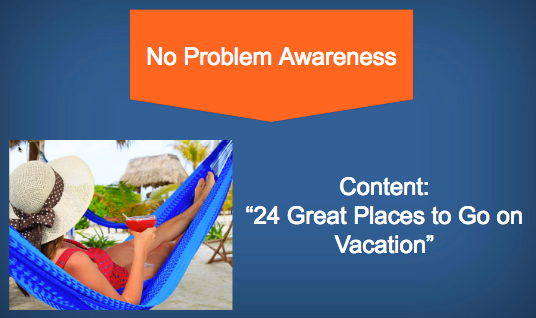
Our research revealed that parents at this stage are very safety conscious, and we want to reach those that are traveling, specifically to oceans.
We conduct keyword research based on this stage, and find that “ Great places to go on vacation ” is a long tail keyword with high traffic volume. So we create a piece of content, in this case a blog post, entitled “ 24 Great Places to Go on Vacation .”
To make it more credible and useful for parents, we interview a leading expert on safe vacation spots, and feature a pull quote in the content ( you always want to collaborate on content ).
Awareness: Our persona is looking for a safe place to vacation. Let’s start by appealing to that need, and within the content introduce potential issues — including shark attack.
Branding: Our persona isn’t aware we exist. Let’s get on their radar and introduce them to our company in the process.
List Building: To build our subscriber list, we include a highly-visible call to action in the blog post, encouraging readers to sign up for a newsletter that will deliver ongoing updates on safe, unique and fun activities for families.
Link Building: We want other content producers to link to this page, as inbound links improve our overall domain authority and help us rank high on Google for keywords further down the funnel. So we’ll recruit expert collaborators, or produce our own research to help this post rank.
Traffic: Obviously, we need to get more people to our site, so if we can rank for this long tail keyword, we’ll start driving traffic to it — even if the visitor isn’t ready to buy at this stage.
Important: People who read this post may never buy. But as long as we get inbound links, further down the line that can help our buying pages rank higher. To understand how this works, check out this post on “ Explaining to Your Boss How Content Marketing Works .”
- Blog subscriptions
Customer Journey Stage 2: Problem – Solution Awareness Stage
It should be noted that any customer can join into the Customer Journey at any point. You just need relevant content ready and waiting for them as they make their way through.
Our next two stages — which tend to overlap — are the problem and solution awareness stages.
Buyers at the Problem Awareness stage realize that shark attacks are a threat. Someone who has Solution Awareness not only knows about shark attacks, they realize that shark repellents could solve the problem.

Problem Awareness: Our keyword research for the problem awareness stage reveals that “shark attack” gets high volume. We then create a piece of content that makes people aware of a problem. “ 24 Ways Shark Attack Can Ruin Your Vacation .”

Solution Awareness: While we want our buying page to rank #1 for “Shark repellent,” we can use it here with a long tail keyword, “How shark repellent works.” Our content will then be tweaked to integrate the keyword and appeal to the persona: “How Shark Repellent Works and Prevents a Gruesome Death.”
At this stage, we’re still building up inbound links and new blog subscribers, but we also want to move them down the buying journey. So we might link from the problem awareness post to the solution awareness post, for example.
We also always want to give people an opportunity to buy, as everyone’s content journey is different. Our case might be so compelling that they might want to buy right away.
- Click-through to next stage content
- Click-through to buying page
Customer Journey Stage 3: Comparison
At this point, a customer is comparison shopping. They’re researching how your shark repellent compares to other shark repellents. And so you want to be there with a comparison piece, even comparing yourself to the competition.
Absolute honesty can be your friend here, and further endear you to your target market. I’ve seen HubSpot compare itself side-by-side to Marketo, for example, and give props to Marketo in areas where they shine. In the process, HubSpot also illustrated its strength to its respective target market.

If you don’t have a strong brand name yet, a comparison keyword might be “Best types of shark repellent.” If there are variations of shark repellent, it might result in a comparison such as “ Deep sea shark repellent vs. kid-friendly shark repellent. ”
Content in these cases is best displayed in a graphic, such as a table, with a side-by-side comparison.
Buyers who reach this comparison stage are probably going to make a purchase soon, so you really want them to take that next step by going to your buying page. Use a bold call to action, and include an incentive to click through (25% off shark repellent!). These folks are primed for action!
Customer Journey Stage 4: Buying
Finally, your website visitor has reached the Promised Land – the Buying stage. You’ve been answering questions, providing great product details, and making an open-and-shut case for Bob’s Shark Repellent .
Now it’s up your direct marketers to close the deal, with a killer landing page and an absolutely seamless e-commerce checkout.
As we mentioned, your content here should be all about buying. At the No Problem and Problem Awareness/Solution Awareness stages, your content was more informative. Now it’s time to make your case for the purchase.
Don’t go it alone, however. Use customer testimonials, data, and social proof to really back up your product or service.
Naturally, you’ll be optimizing for “ shark repellent ,” but your keyword research may indicate variations on the term and other semantic keywords that can help you rank.
Conversions: Without a doubt, this is what it’s all about! You can track conversions either through forms or phone calls, but this is the absolute goal of this page.
- Conversions
Customer Journey Stage 5: Implementation and Customer Success
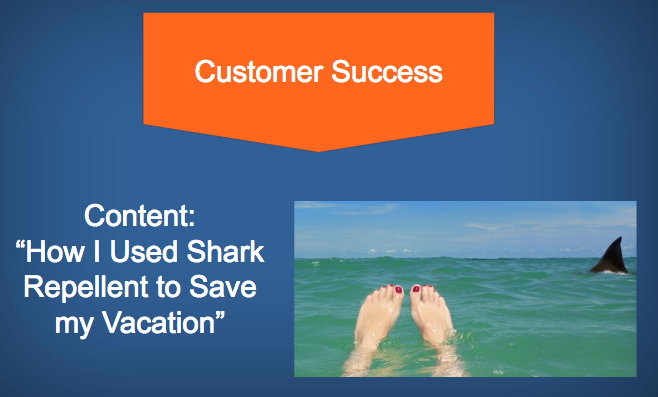
Post-buy, the Customer Journey continues with Implementation , in which you can deliver great content on how to use Bob’s Shark Repellent (shield the eyes, apply before donning your swimsuit). You can also beef up your social proof by harvesting customer success stories.
Reduce phone calls and other support requests: Content can continue to help your new customers, even after they’ve made a purchase. Ensure your customers stay long-term customers by providing exceptional implementation content, such as “How do I….” posts. Make it easy for buyers to use your product or service to their best advantage by answering their questions.
This can also reduce your support costs, as questions answered seamlessly via your content will eliminate calls and emails from confused customers.
- Reduced support calls, requests for help and customer service costs
How to research keywords throughout the Customer Journey
Now that we’ve walked through the Customer Journey, you can see a gold mine of opportunities to unearth keywords and blog topics. There are endless possibilities in terms of content.
A variety of keyword research tools (our favorite is SEMrush) and methodologies exist for finding these keywords (which will be the subject of our next blog post — so be sure to subscribe to the Winbound blog to get it).
However, we recommend you consider four important approaches to finding the right keywords:
Review Your Existing Content
If you’ve already generated quite a bit of content, map out your existing content based on which stage of the Customer Journey it addresses. You may find that you’re overloaded with content related to the Problem stage, but light in the Solution stage. That can help you diagnose what you should focus on in the upcoming year when generating content.
Pro tip: You have tremendous opportunities here to combine old pieces of content into one, extensive piece. We combined four, low-performing articles for one client into a 2,500-word behemoth, using key points covered by each individual piece. Together, they provided the substance to vault the content and up the keyword rankings.
Brainstorm Topics
Get your team together and brainstorm topics throughout the Customer Journey. These will likely be broad-based topics with high search volume (Shark attack, Safety at the beach). Once you have a big list, you can use a tool such as SEMrush to drill down and discover other keywords, identifying potential opportunities.
Research Competitor Keywords
Don’t do all the heavy lifting yourself. Research your competition with a keyword research tool, and find out which keywords they rank for. You may find opportunities you’ve overlooked.
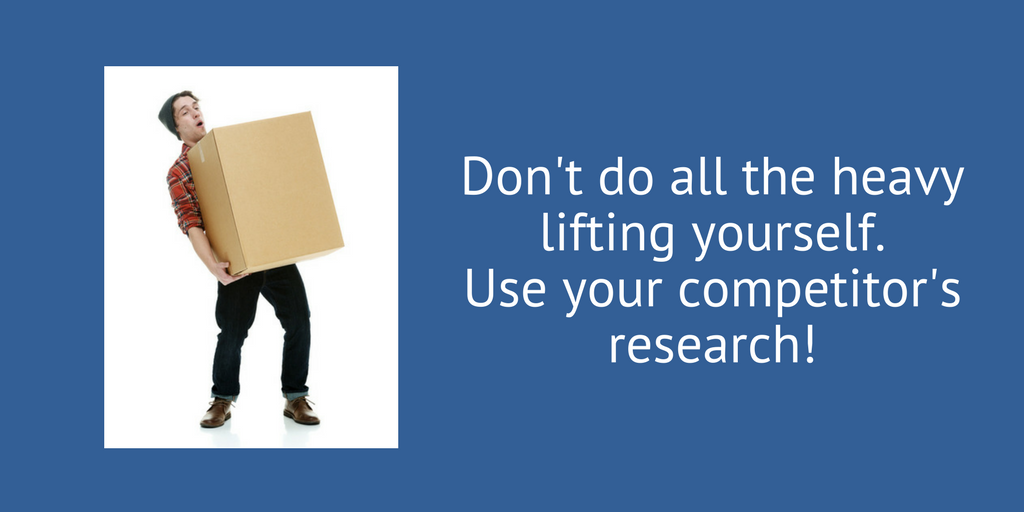
For example, one of our clients was completely focused on “positive” keywords, overlooking all the negative keywords associated with their product. (There was a lot of conflicting — and often incorrect — data regarding their product.) They were missing a golden opportunity to provide a counterpoint.
Research Long Tail Keywords
These are great places to find low-hanging fruit — keywords that often don’t have much competition, that eventually you can rank for.
A lot of these will be identified as you drill down into your topics. But there are methods to find related long tail keywords. We’ve identified some tactics in the post, “ How to update website content and improve keyword rankings .”
An eye-opening experience for marketers and business owners alike
Plotting a Customer Journey is a highly-disciplined, sometimes grueling exercise in really diving into the content on your site and the content you need to create. It’s an opportunity to stop selling long enough to think deeply about what actually motivates your customers to buy.
In the end, you’ll see the Customer Journey is also a Marketer’s Journey. Start yours now.
Find out how your content and conversion ranks with our interactive version of the Content Scorecard you can fill in yourself – no email required for download.
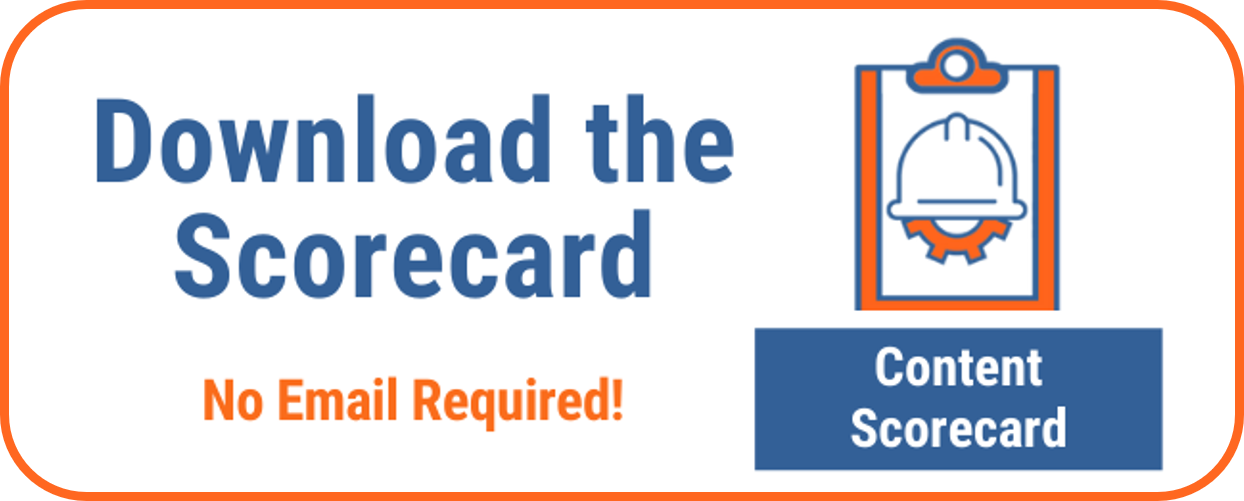
Greg Mischio
Pin it on pinterest.
Navigation Menu
Search code, repositories, users, issues, pull requests..., provide feedback.
We read every piece of feedback, and take your input very seriously.
Saved searches
Use saved searches to filter your results more quickly.
To see all available qualifiers, see our documentation .
- Notifications
A reference containing Styles and Keywords that you can use with MidJourney AI. There are also pages showing resolution comparison, image weights, and much more!
willwulfken/MidJourney-Styles-and-Keywords-Reference
Folders and files, repository files navigation.

DISCLAMER: I am not officially affiliated with MidJourney. I am simply a user/member who enjoys using their service.

Comparison Pages

Created By Will Wulfken
Sponsor this project, contributors 9.
- Channel Marketing
May 24, 2022 | 11 min read
How to Use Keyword Mapping for the Buyer’s Journey

Let me ask you a question: What if you’ve got your keyword research all wrong?
I ask because most marketers use the same broken process:
- Hop onto a keyword tool
- Plug in some industry-specific keywords
- Extract the keywords that they feel their customers might search for
And inevitably, put these generic keywords to use in their content.
The result?
It has no impact on their search engine rankings, and it moves no needles for their sales process.
Generic keywords spewed from a keyword tool don’t match the search intent of your prospective customers.
Let me explain.
For years, attracting prospects online and converting them into customers was a short and sweet process.
Now, the buying cycle is longer and more intricate. Customers go through an entire journey of not even knowing that they have a problem, to them finding your solution.

(Source: AidenMarketing.)
It’s not until the end of that cycle that they evaluate their options and make a final purchase decision.
That’s where search intent comes in.
At each stage of this buying cycle, your prospects will use different search queries to match their intent.
If you can predict what those search queries are at each stage of their journey, you can create the type of content that will influence their purchase decision.
Do you see how this can be a powerful conversion tool?
The best part is, it’s way simpler than it sounds.
In this article, I’ll show you exactly how you can map your keyword research process to your buyer’s journey.
Let’s jump in.
Keyword Mapping Basics
The Buyer’s Journey
Buyer Personas and How to Map Your Buyer’s Journey
Keyword Mapping: The Types of Keywords for Each Stage of the Buyer’s Journey
How to Expand on Your Keyword Data
How to Assess Keyword Competitiveness at Each Stage of the Customer Journey
The Buyer’s Journey
Before we get into keyword research, here’s a quick refresher on the buyer’s journey.
The buyer’s journey is the path that customers take all the way from researching a product to making their final purchase decision.
Why is this journey such a big deal?
If you know what customers are doing at every point of interaction with your business, you can optimize this process for conversions.
There are three stages in the buyer’s journey :

(Source: Trellis .)
Here’s a brief overview:
1. Awareness
At this stage, the buyer has become aware of their problem, they’re on the hunt for information, and they’ve reached an important tipping point.
What does this mean for your business?
The opportunity is prime for them to discover you.
If you play your cards right, this is where buyers will make the first point of interaction with your brand.
Your task is to ensure that you create content that is optimized for the search queries that they’ll be using at this point.
2. Consideration
Here, buyers are acutely aware of their problem and have stumbled across your solution.
The consideration stage is where a buyer is the most engaged. They’ll be dissecting and evaluating all their possible options and will also be considering your solutions.
Your ability to outperform your competitors on all marketing fronts is tested at this stage.
3. Decision
At this point, your buyers’ minds are made up and they will be making their final purchase decision. .
The decision stage is where the magic happens. Your chance to make a sale is right here.
Now that you have an overview of the three phases of the buyer’s journey, the work begins.
You need to get a solid grasp of who that ideal customer is to you.
If you don’t get clear on that, you won’t understand how they move through your sales and marketing funnels.
That’s where buyer personas come into play.
Buyer Personas and How to Map Your Buyer’s Journey
You’re probably tired of hearing about personas at this point.
But here’s the thing:
This simple map of your ideal buyer has utility in every pillar of business.
From offer validation to email mar k eting , your customers are the ones fuelling these engines.
They’re the ones that matter.
What are their needs? What keeps them up at night? What’s going to drive them towards your solution?
Discover that, and you’ll be well on your way to outranking your competitors in organic search .
Here’s how you can find information about your ideal buyer.
i. Look at your website and social media data
You don’t have to look past your analytics to find key data points on your audience.
In fact, you can use Facebook Insights to find demographic information as well as the type of content that your audience responds to best.
I also recommend Google Analytics to gain insight on how users engage with your website.
What are your popular sources of traffic? Which pages are the most popular? From what segment of your audience is this traffic coming from?
ii. Talk to your customers to get into their heads.
The single best way to get insight into your ideal customers is to talk to them. Survey your email list and use polls for your social media audience.
Ensure that you ask questions that will help you determine their behaviors at each stage of the customer journey.
Here’s what you should be looking for:
- What are buyers’ challenges and objectives at each stage?
- What steps do they take to get informed about these challenges?
- What type of content do they respond to at each stage?
- How much do they participate and engage? (You’ll likely find that customers are way more involved during the consideration stage)
- What are their interactions with your brand?
After you’ve gotten this insight, you can now connect the dots to create your persona and map your customer journey.
With this information in hand, it’s time to do your keyword research.
Keyword Mapping: The Types of Keywords for Each Stage of the Buyer’s Journey
Knowing your ideal buyer is great.
Knowing how they navigate through your sales funnels is even better.
But knowing what keywords they use at each stage is everything .
I’ll tell you why.
At each stage of their journey, buyers have different needs. It means that each time, they will approach their search process with a different intent.
By extension, they’ll be using different keywords to communicate this intent.
Does that make sense?
Let’s break it down some more.
Understanding User Search Intent
Keyword research and search engine optimization are all very technical, right?
In many ways, yes.
But SEO has as much to do with people as it does with search engines.
Many marketers overlook the human element of keyword research because they think it’s all about robots.
That’s a giant misconception.
Imagine this scenario:
- You’re an end user on the hunt for information.
- You type in a few search queries to find that information.
- You click on the first few results in the search engine results pages (SERPs).
- The content on these pages is irrelevant to your search query.
You’d be annoyed, right? Sure you would.
After all, you’re no more informed than you were before you conducted your search.
That’s why search intent is a critical component to keyword research.
It adds context to the process.
In other words, it will allow you to provide the right information to the right people at the right time.
Search engine robots can’t do this for you.
They have, however, simplified the process considerably.
Google defined four micro-moments that describe most search queries:
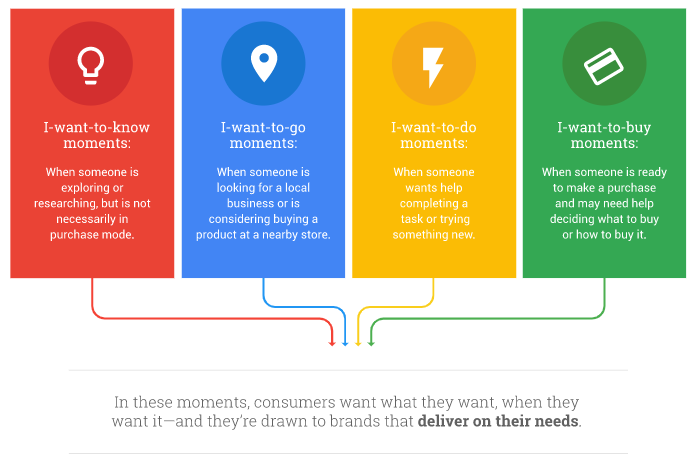
(Source: Thinkwithgoogle.)
It’s up to you to do your due diligence of getting to know how these apply to your audience.
The result? You provide infinitely more value to your users.
In turn, your clickthrough rates increase, your SEO performance improves, and your overall brand equity is elevated.
With that out of the way, how do you find keywords for each stage of the customer journey?
Let’s find out.
How to Find Informational Keywords for the Awareness Stage
At the awareness stage of the customer journey, buyers will be using informational keywords . As the name suggests, these are the keywords that customers use when they’re conducting research.
From an e-commerce perspective, these queries aren’t immediately valuable because they have very little commercial intent .
From a holistic marketing perspective, these keywords are gems.
If you can position yourself as an authority, this will positively impact your lead generation efforts.
The more leads you collect at the top of your marketing funnel, the more conversions you can have at the bottom of your funnel.
It’s also going to help you gain trust with your audience. With informational keywords, your focus is on providing value to readers.
You won’t be creating content that’s geared towards landing a sale.
Why is this important?
According to this survey , users frown upon an excess of promotional content. Almost 60% of social media users say they’re annoyed by too many promotional posts.
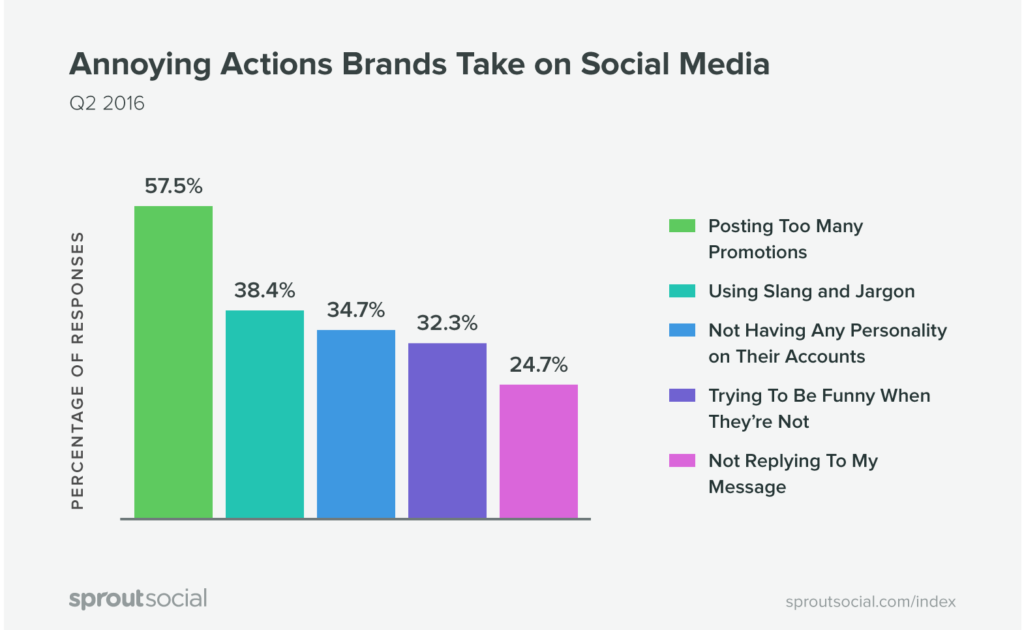
You now know how important informational keywords are.
Let’s find some.
Use the following questions to brainstorm your informational keywords:
- What problem does your product solve?
- What transformation will your product bring?
- What words will buyers use to describe their problems and their aspirations for transformation?
- What attitude does the buyer have towards their problems and potential solutions?
For example:
Let’s say that you’re selling a tool which helps to optimize websites for converting leads.
Using the questions above as a guideline, here are some of the queries that a buyer might search for:
- “Grow my email list.”
- “How to get email subscribers fast.”
- “How to create a lead magnet that converts.”
- “What’s the best way to grow an email list?”
- “How to build an email list from scratch.”
Go ahead and brainstorm some ideas for your product.
You can also use a simple Google search to help you.
Plug in your general keyword in the search bar, and you’ll get even more ideas from Google Suggest:

Go through with your search and scroll down to the bottom of the page. There you’ll find more searches related to your keyword:
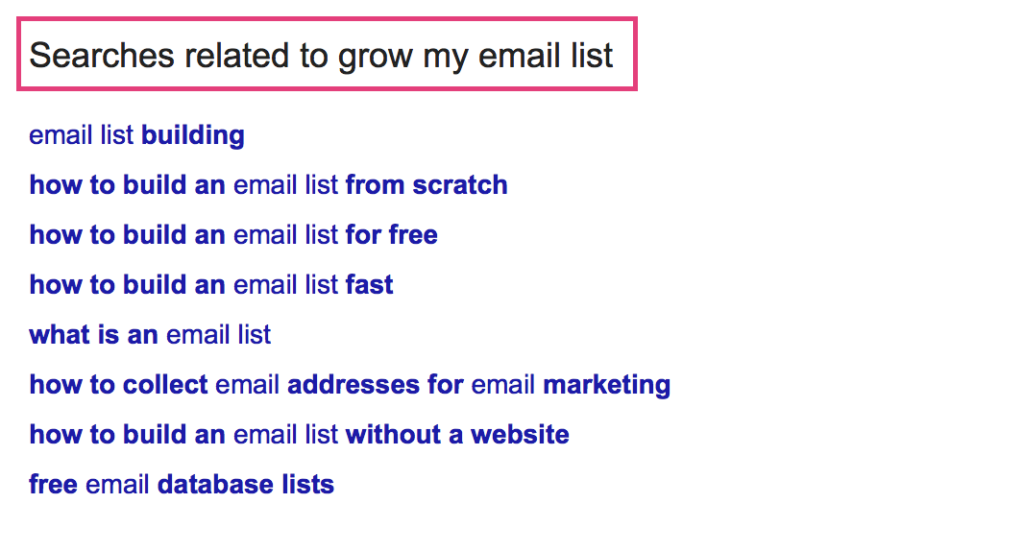
I recommend taking this search across several layers. Click on one of the options and check out the related keywords as well. You’ll get even more detailed ideas:
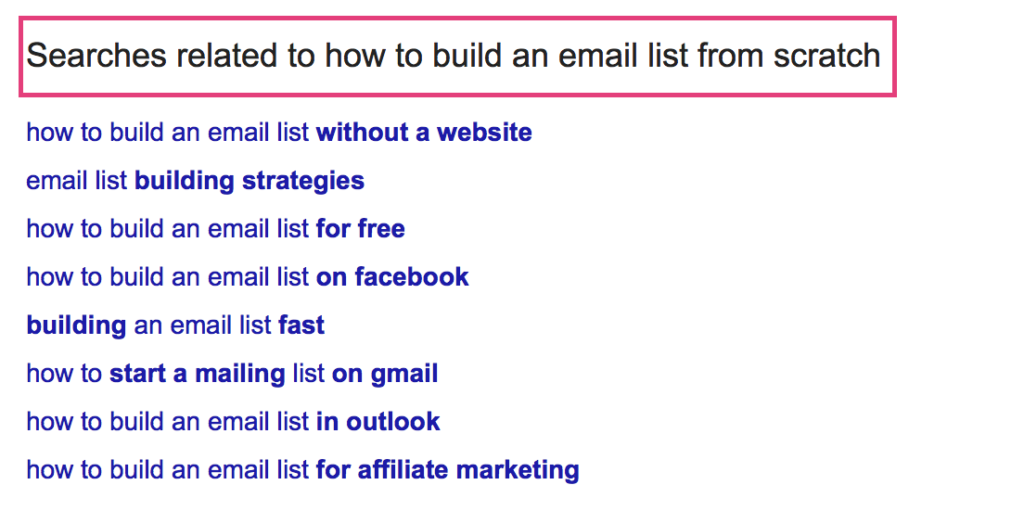
Repeat this process until you have a sizable list of targeted long tail keywords.
Take a note of all these search queries. You won’t use all of them, but it gives you options.
How to find navigational keywords for the consideration stage
At the consideration stage of the buyer’s journey, users will be searching for navigational keywords .
These are search queries that correspond to a product, company, or brand name.
Be mindful that potential buyers will be looking at both your products and that of your competitors.
That means that you need to consider your competitors’ keywords as well. To do that you need to find what these competing products are.
Some places you may search include:
- Google paid ads
- Facebook paid ads
- Other online marketplaces
After you’ve got an idea of who your competitors are, consider these questions for coming up with navigational queries:
- What is your brand known for?
- What are the frequently asked questions for your product?
- What are the pros and cons of your product?
- How do buyers feel about these pros and cons?
- Which products out there are competing with yours both on price and benefits?
- What category does your product belong to?
Transforming these questions into search queries is simple.
Here are a few examples:
- A buyer searching for frequently asked questions might simply search for: [Product name] FAQ
- A buyer searching for product comparisons might search for: [Product name] versus [Competing product] or [Product name/competing product] Pros and Cons
- A buyer searching for a brand’s overall history with a particular product category might search for: [Brand name] + [Main Keyword] or [Brand name] + [Product Category]
Take a note of the keywords that you come up with.
How to Find Transactional Keywords for the Conversion Stage
At the conversion stage of the customer journey, buyers will be using transactional keywords .
These are search queries that indicate high commercial intent.
In other words, if a buyer uses these search terms, they’re more than likely primed for purchase.
Consider these questions:
- What do prospects need at the exact moment that they’re about to make a purchase?
- What are some of the things that will get them through the cart faster?
- Are buyers the sole decision makers? Who do they have to consult before making that final purchase?
- What expectations do they have for a transaction?
Again, it’s simply a matter of using these questions as activators for coming up with your transactional keywords.
For example, to help them make a purchase, buyers may search for coupons and promotional offers. They may use this formula: [product name] discount.
Beyond the Conversion Funnel: How to Find Keywords to Improve Customer Retention and Loyalty
Your potential buyer has converted into a customer.
You’ve made the sale.
Does your work stop there? Not unless you want to lose that customer.
Most people don’t optimize their content beyond the conversion funnel, but it is critical to your business.
It doesn’t require much legwork to optimize this stage.
Customers will also be using navigational keywords. Only this time, it will be more targeted to the product that they purchased.
Consider these questions:
- What problems do new customers complain about?
- What steps do customers have to take to use your product correctly?
- How can customers get additional functionality out of your product? Are there any integrations or add ons that they can use?
It’s not difficult to find this information.
You can search through product-specific Facebook groups. You can also go to third party review sites, read the reviews, and see what customers are saying about your product in the comments section.
Take a note of all the queries that you come up with.
At this point, you should have keywords for each stage of the buyer’s journey.
But they’re just ideas.
How do you know the potential of each keyword and which ones to target?
It’s all in the data.
How to Expand on Your Keyword Data
Now that you have some keyword ideas for each stage of the customer journey, it’s time to use a keyword tool to get some concrete data.
I recommend UberSuggest .
First, plug in your keyword and press “Suggest.”
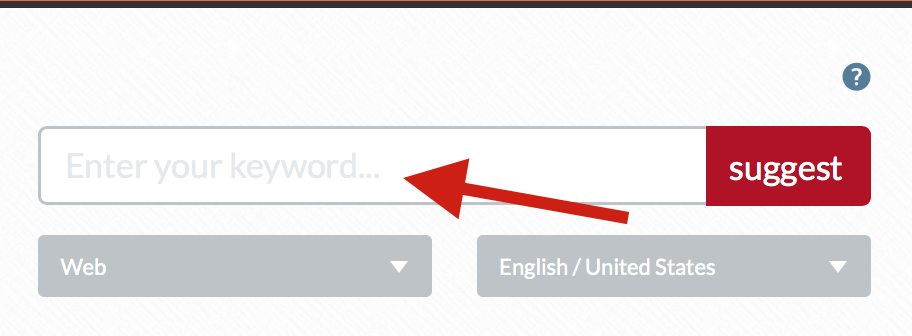
You’ll get a massive alphabetized list of keywords. Here are my results when I type in “keyword research.”
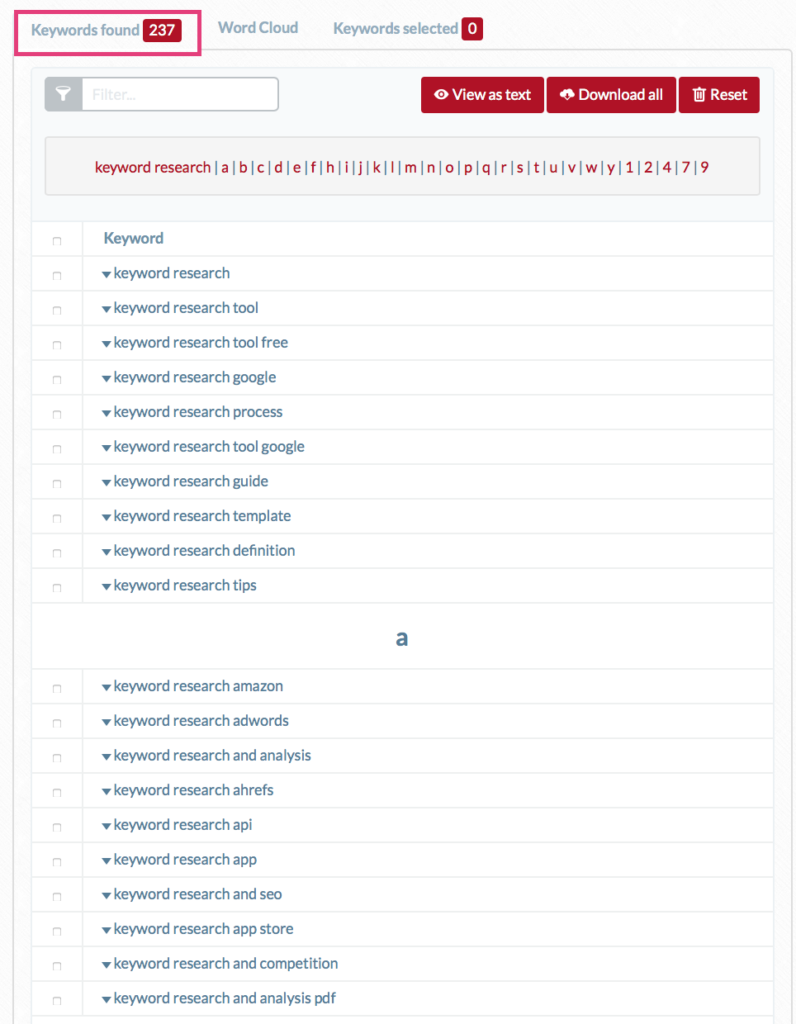
As you can see, I got 237 additional keyword ideas for that one search query. There’s no way all of these will be useful or relevant to me.
The key is to pick the ones that align with your business.
What about the search volume and other metrics attached to these keywords?
After you’ve gotten concrete terms from UberSuggest, go to TermExplorer to get this data.
Find the tool and click on “Start a Keyword Analyzer Project.”

Name your project and enter your keywords. You can analyze up to four keywords at once.
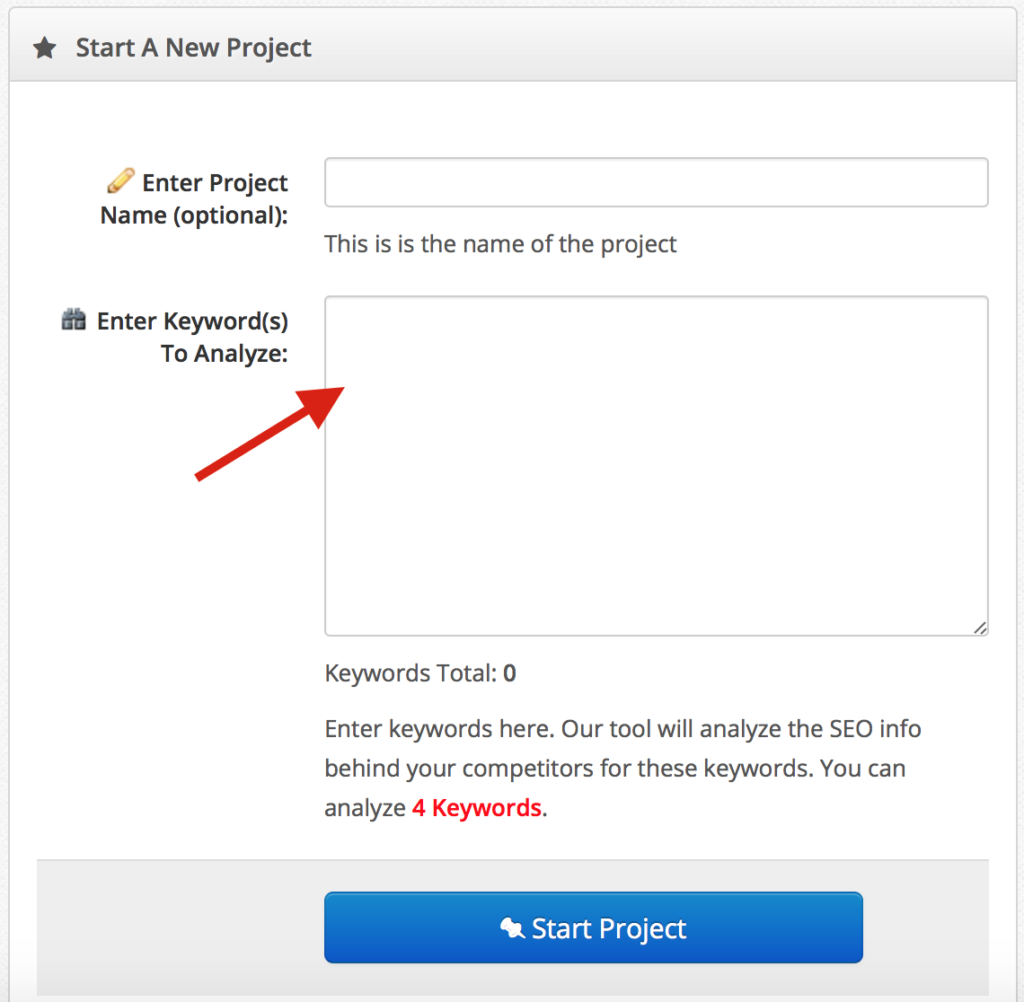
You’ll get metrics like:
- Average search volume
- Keyword difficulty
- Average CPC
- Relevancy
- Link Strength
- Trust
You can then export your keyword data.
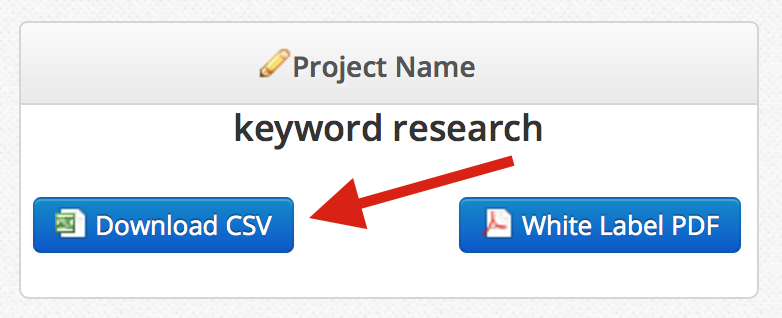
How to Assess Keyword Competitiveness at Each Stage of the Customer Journey
Why is competitiveness important?
If you know the level of competition for a keyword, you can select the ones that you have a realistic chance of ranking for.
A big part of it has to do with which stage of the customer journey you’re looking at.
As you progress down the marketing funnel, keyword competition increases. By this standard, commercial and transactional keywords will be the most competitive.
That’s not to say that informational keywords aren’t competitive because they are.
But that’s the objective way of looking at keyword competition.
In truth, deciding which keywords to target requires more than simply looking at their competitiveness.
What resources do you have at your disposal? What marketing strategies will you be using? What are your objectives?
These will all have an impact on your keyword choices.
Let’s say that you don’t have a sizable budget to invest, and you want a purely organic strategy.
You may not be able to compete for commercial keywords in a paid campaign, but you will have a chance at the informational keywords.
Or, if your goal is audience-building, there’s no need to target these transactional keywords.
Does that mean your marketing efforts won’t influence conversions? Of course, it will!
What you do at any stage of the customer journey has a trickle-down effect. It will impact your conversion rates. It simply means your marketing cycle will be longer.
And that’s okay.
The bottom line?
The keywords that you target are all up to you, your resources, and your business objectives.
Conclusion
Conducting keyword research is way more nuanced than marketers have it made out to be.
If you want to create the type of content that drives leads and converts customers, it’s important that you take into account the end user.
Their search intent and the way they navigate through your marketing funnels make all the difference.
Get acquainted with that, and you’ll have no problem attracting and converting the type of audience that fuels your revenue goals.

Emil Kristensen
Emil is the CMO of Drip. When he’s not busy writing awesome content and building the Drip brand, he spends his time reading blog posts and listening to podcasts.
Come for the automated marketing. Stay for the endless revenue growth.
Start a 14-day free trial, no credit card required.
Related posts
Learn more about drip.

How To Select The Best Keywords For Every Stage Of The Buyer’s Journey
By remington begg | march 14, 2017 at 9:00 am.
In today's digital savvy world, effective keyword research is an increasingly important skill for digital marketers. Not only do they need to know how to develop a good keyword list for Pay Per Click (PPC) and Search Engine Optimization (SEO), but highly skilled marketers need to know how to use keyword research to figure out what topics they should be writing about.
Keyword Research Defined
According to Hubspot , “Keyword research is when people use keywords to find and research actual search terms that people enter into search engines. The knowledge about these actual search terms can help inform content strategy, or marketing strategy overall.”
Seems pretty straightforward, right? Well it can be. The tricky part is when you start to get into the different stages of the buyer's journey. You’ve got to remember that your keywords will not be the same for everyone. Since your buyer personas are going to be in different stages of the funnel, they are going to be searching for different content. Different content means different keywords.

Let’s take a deeper dive into each stage of the buyer’s journey to figure out what each persona may be searching for, then we will look at a real life example to help you understand even further.
The Buyer’s Journey
When strategizing for your keyword research, you can start by following the three-stage funnel of the Buyer's Journey: The Awareness stage, the Consideration stage, and the Decision stage. Buyers in each stage of the funnel are going to be looking for different information according to their needs.
The Awareness Stage
The funnel starts at the top with the "awareness" stage. During this stage, people are looking for answers, resources, education, opinions, and some kind of insight to their problem.
You’ll want to aim to educate and provide value during this part of their search. The keywords people will be searching for are going to revolve around their pain points.
Let’s take for example, a business that provides CRM software. A buyer in the awareness stage is probably a manager at the beginning of their search, who is currently doing their customer service manually and is unable to keep up with the flow. A search phrase they may type into Google could be, “how to save time with customer service and support.”

The Consideration Stage
Once they have decided what their pain point is (saving time with customer service), they can work to correct it. Buyers will now move to the “consideration” stage of their journey. The consideration stage is the middle of the funnel and also known as the evaluation stage.
While the top of the funnel is used to educate the potential buyer, the middle of the funnel is used to nurture and build trust. This is where people are doing heavier research on whether or not your service is a good option for them.
This is the stage to provide content that shows why your service is worth purchasing. Using our example, the CRM provider would now begin talking about how much the buyer would save in lost productivity time and excess wages.
Keywords and phrases to focus on would be words that are relevant to your services and/or products such as, “How Customer Service Automation and CRM’s can save you time and money”
The Decision Stage
The “decision” stage, also known as the “purchase” stage, is at the bottom of the funnel. At this point, people have narrowed down their options to make a decision. At this final stage of the buyer’s journey, you will need terms that are specific to your brand and products.
Buyers in this stage are ready to make a purchase. Target keywords that will bring the buyer to your live demo page or free trial download page.
Keyword Research is essential to SEO
The main point of keyword research is to see which search terms are popular so that you can build your blog strategy and PPC campaigns around them. You want to select the right words, so take your time during this process. If you skip keyword research, you risk the chance of creating high-quality content on something that no one is searching for.

How to Map Your Content to the Buyer's Journey
By Sean Filidis
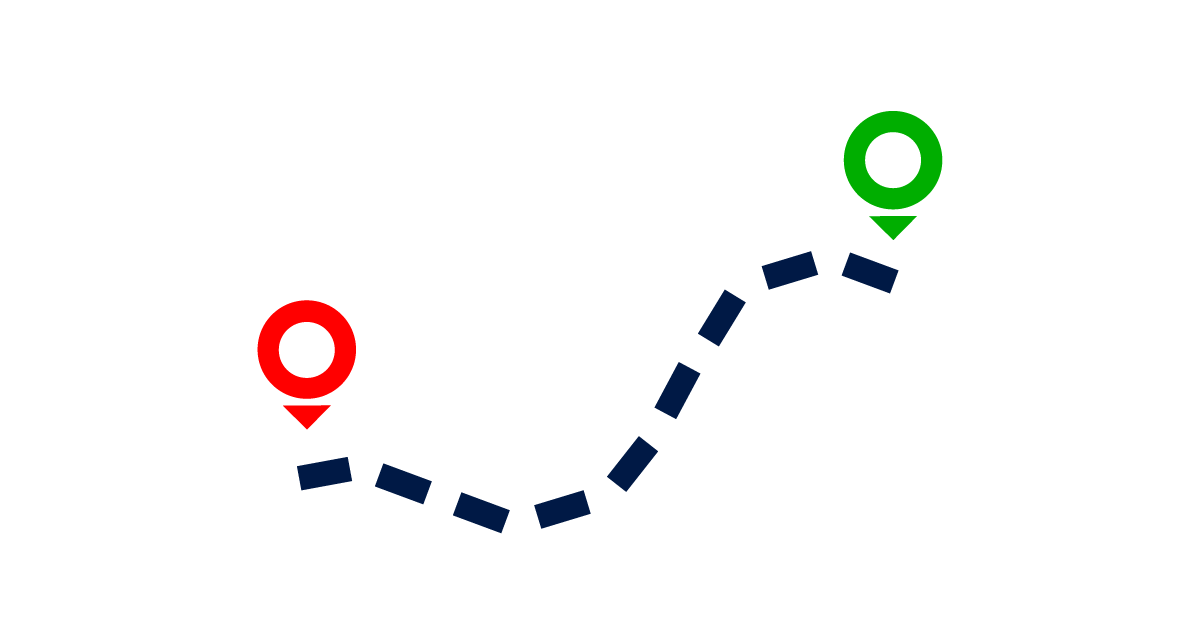
If you’re a digital marketer, you've undoubtedly dabbled in content marketing. Content marketing is more than writing about your product or service. It’s a powerful and popular way to get your messaging in front of your ideal audience, build trust and relationships, and hopefully convince them to engage with your website or product.
However, content marketing can also be overwhelming. It’s possible that you’re working with a sea of content types — such as blog posts, newsletters , eBooks, case studies, white papers , and webinars — and wondering what goes where. What content is right for your organization? What will connect with your ideal audience and inspire them to become customers?
By looking at how people develop a relationship with your brand over time (commonly called the buyer’s journey ), and determining what kinds of content are most helpful for people in each stage of their journey, you can anticipate what type of material you’ll need.
In this post, we’ll explore this process and deliver actionable insights that will help you create an intelligent content strategy .
What is the buyer’s journey
Knowing what types of content you should use is complicated. However, once you understand how to employ the concept of a buyer’s journey in your content strategy, you’ll substantially increase your success as a digital marketer.
The buyer’s journey is a framework that explains the steps someone goes through in discovering a problem he or she has, researching that problem, and eventually purchasing a product to solve that problem.
As can be inferred from that definition, there are three stages to the buyer’s journey: the awareness stage, the consideration stage, and the decision stage.
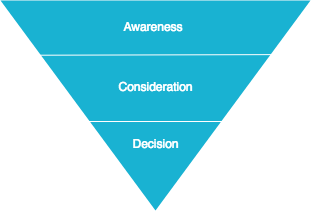
In the awareness stage, the potential buyer is confronted by some problems. They’re aware of their frustration but don’t yet know precisely what’s causing it or whether it’s unique. This is typically when someone searches online for the symptoms of their problem, looking for any information they can find.
People in the awareness stage are not ready to be sold to, but they will be highly receptive to any source that helps them name and frame their problem. They are still formulating the vocabulary around the issue that will help them search for a solution.
This is a great time to make people aware of your brand. If you can provide information that helps them understand an issue they are facing, and if you can optimize that content around the search queries they’re using, you will rank highly, and visitors will take note of you.
Blog posts that articulate and describe a problem, help readers contextualize that problem and highlight a number of approaches to solving it are most likely to resonate with people in the awareness stage.
Observe how the following blog post titles focus on attracting visitors who are still trying to define and understand whatever issue they’re facing:
- 11 types of back pain and what might be causing them
- The top 5 reasons web content fails to convert visitors
- Why your CRM is so messy (and how to fix it)
These 3 titles cater to potential visitors who are experiencing frustration but have not yet nailed down exactly what’s causing it or what kind of solution to investigate. Visitors are likely to click on these titles because they promise more information that will help them clarify the question they’re facing.
Content targeting the awareness stage should aim to educate, define, contextualize, clarify, and inform. The best way to draw visitors into your funnel is with content that helps them understand their problem and prepares them for the next step: searching for a solution.
Consideration
In the consideration stage, potential buyers better understand the cause of their problem and are now researching various kinds of solutions. How and where they search depends on the information they received and the vocabulary they developed in the awareness stage, which is why that stage is so critical.
In this stage, the potential buyer is still not ready to make a purchase, but they are eager to give things a try. Content in this stage should encourage users to start free trials, request product demos, or download solution-oriented offerings like eBooks and white papers .
Want to know more about creating great white papers you can measure? Learn more
These conversions are valuable because they allow you to showcase the benefits of your product while also gathering prospects’ contact details. The goal here is to enable potential buyers to give proper consideration to your product or service with content that demonstrates precisely how you propose to solve their problem.
Other forms of content highly suitable for this stage are:
- General FAQs
- Product brochures
- White papers and eBooks
- Explainer videos
Content targeting the consideration stage should aim to explain and even demonstrate how your product or service will effectively solve the specific problem the buyer identified in the awareness stage — and ideally get them to try it out themselves.
During the decision stage, the potential buyer has a handful of products or services they’re investigating in depth. They know more or less what they want in a solution, and they’re looking for the one that best fulfills their criteria. At the end of this stage, the buyer will likely make a purchase.
Your goal in this stage is to persuade prospects to purchase your solution rather than a competitor’s. Content for the decision stage should flaunt the merits of your solution and provide clear evidence of how it helped others who faced similar problems succeed.
Marketing Collateral ideal for the decision stage include:
- Case studies / success stories
- Instructional videos and tutorials
- Product documentation
If you offer a software solution, tutorials and documentation inspire confidence that once the potential buyer makes a purchase, they’ll have robust instructions that allow them to get started immediately. If prospects are comparing you with other similar solutions, this type of support material can play a big part in their decision.
Also consider the content on your pricing page, online store (if applicable), and automated notifications reminding them that their trial is going to expire. These are critical for the decision stage and may spell the difference between a prospect choosing you, or choosing your competitor.
Content targeting the decision phase should aim to give evidence of expected results and persuade prospects that your solution is the best choice among many.
As you can see, understanding the buyer’s journey helps you present the right type of content to potential buyers at the right time. The challenge now is to determine where each of your current assets belongs in that journey.
Learn more about the buyer's journey in our complete guide to Content Marketing .
Mapping your content
The best way to begin applying the buyer's journey and start getting strategic with your content efforts is to perform an audit of all your existing assets.

For each content asset you have — whether a blog post, case study, web page, video, eBook, or something else — you should determine where in the buyer's journey it belongs and how effective it is in moving prospects further through your funnel. This allows you to do 2 things:
- Identify content gaps in your funnel
- Optimize content according to where it belongs
The goal of a content audit is to get a complete picture of what content you currently have running , its performance, what pieces are planned for the next several months, and their projected performance.
If this is beginning to sound like lots of work, that’s because it is! Effective content marketing is no walk in the park, but it pays off.
Identifying gaps with a content audit
Create a spreadsheet that includes every piece of content your organization has created and is currently planned for the future. The spreadsheet should have columns for its status (published or planned), its type, its title, the stage of the buyer’s journey it targets, the persona it targets (keep your eyes peeled for a future post from us on personas), and the URL.
Merely filling out this sheet will give you a great idea of where content might be lacking. You might notice, for example, that the majority of your content addresses the decision stage and that you have very little geared towards awareness. Or perhaps your awareness stage is well-covered but you lack in consideration stage content.
Identifying gaps helps you plan for the future. Focus your content creation efforts on filling these gaps and ensure that every buyer's stage / persona combination is well covered with quality content.
Establishing goals for your content
The point of mapping content to your buyer's journey is to be more effective in drawing visitors through your funnel by presenting them with the content they need to take the next step towards a purchase.
So, after determining where in the buyer's journey each piece of content belongs, you need to check whether those assets are really doing their job .
- Is your awareness stage content helping people define their problems?
- Do your consideration assets showcase the merits of your solution?
- Are your decision pieces persuading prospects that your offer is better than those of your competitors?
Before you can answer these questions, you need to decide on some measurable goals. Goals allow you to gauge the effectiveness of each piece of content and then optimize them accordingly.

The goals you set for each piece of content depend on both the buyer's stage they belong to and the type of content . Only once you've determined a goal for each asset can you assess its effectiveness and begin to optimize it.
Here are 6 content goals we use at Foleon (though yours may differ):
- Acquisition : To attract new visitors
- Activation : To turn visitors into subscribers (micro-conversion)
- Education : To engage subscribers and keep them coming back
- Revenue : To persuade visitors to make a purchase (macro-conversion)
- Expansion : To encourage customers to upgrade
- Referral : To delight customers and turn them into evangelists
As you can see, the goals don't always have a 1-to-1 relationship with the journey stages. While acquisition and activation are most associated with the awareness stage, activation could also fall neatly into the consideration stage, depending on the context.
What's important here is that assigning goals to content gives you the ability to measure their effectiveness and optimize them.
Optimizing for the journey stages
Now that you've placed each asset in the buyer's journey and assigned them tangible goals, you can decide what metrics are most appropriate to measure.
Make a second spreadsheet, similar to the first one, that includes every piece of content you have, as well as the ones you’re planning. The spreadsheet should have a column for the title so you can relate it to the first one.
Additional columns should include each piece's goal, the number of views, time spent on a page divided by word count, bounce rate, traffic source, conversion rate, and possibly more. Only use the columns that apply to a given piece of content and add columns for more metrics as necessary.
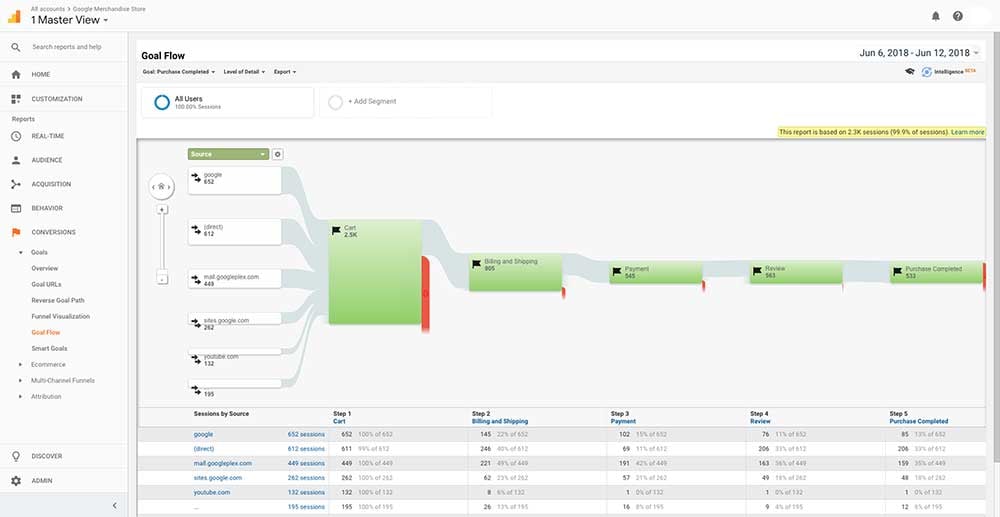
For an awareness phase blog post that offers a downloadable eBook, for example, you would likely be interested in the number of unique users the post acquired, scroll depth, and the conversion rate. For the eBook itself, the number of activated visitors who later returned to your website and viewed your pricing page might be of particular interest.
Case studies are an example of another content type, with different metrics. The conversion you’re looking to drive with case studies is likely a purchase.
Tracking these metrics will show you whether each piece is contributing to its goal and where you have room for improvement. It's a bit of an art, and it takes practice. But eventually, you’ll get a clear picture of the boundaries between each stage of the buyer’s journey and which types of content are effective in moving prospects further.
Filling your funnel
As you fill in your content gaps and optimize assets according to their place in your funnel, you’ll begin to develop a content ecosystem with pieces appropriate for all of your needs. As different prospects move through your buyer’s journey, you’ll always have a good piece of content there to nudge them along.
In this way, you’ll be able to help prospects along the entire journey , from beginning to end. The more robust this ecosystem becomes, the better your conversion rate will become. In turn, this will give you better insights into your buyer’s journey and enable you to create even better content.
This is how marketers sustainably fill their funnel, and this process is what makes content marketing effective .
Foleon & CMI White Paper
How to overcome content creation barriers.
Why the time is now for B2B marketers to develop modern digital content experiences.

Sean is a B2B content strategist specialized in streamlining customer journeys, creating sales and marketing alignment, and producing personalized content experiences that resonate with modern buyers. LinkedIn profile
Want to write for the Foleon blog? Here's how to submit a guest post .
What to read next
B2b thought leadership marketing: rethinking content experiences in 2024.
Sean Filidis
How to Create Detailed Buyer Personas
What is a content experience and how do you make one.
- Do Not Sell My Personal Info

- ⋅
Keyword Research: An In-Depth Beginner’s Guide
Keyword research is the foundation of search engine optimization. This guide covers what it is and how you should do keyword research.
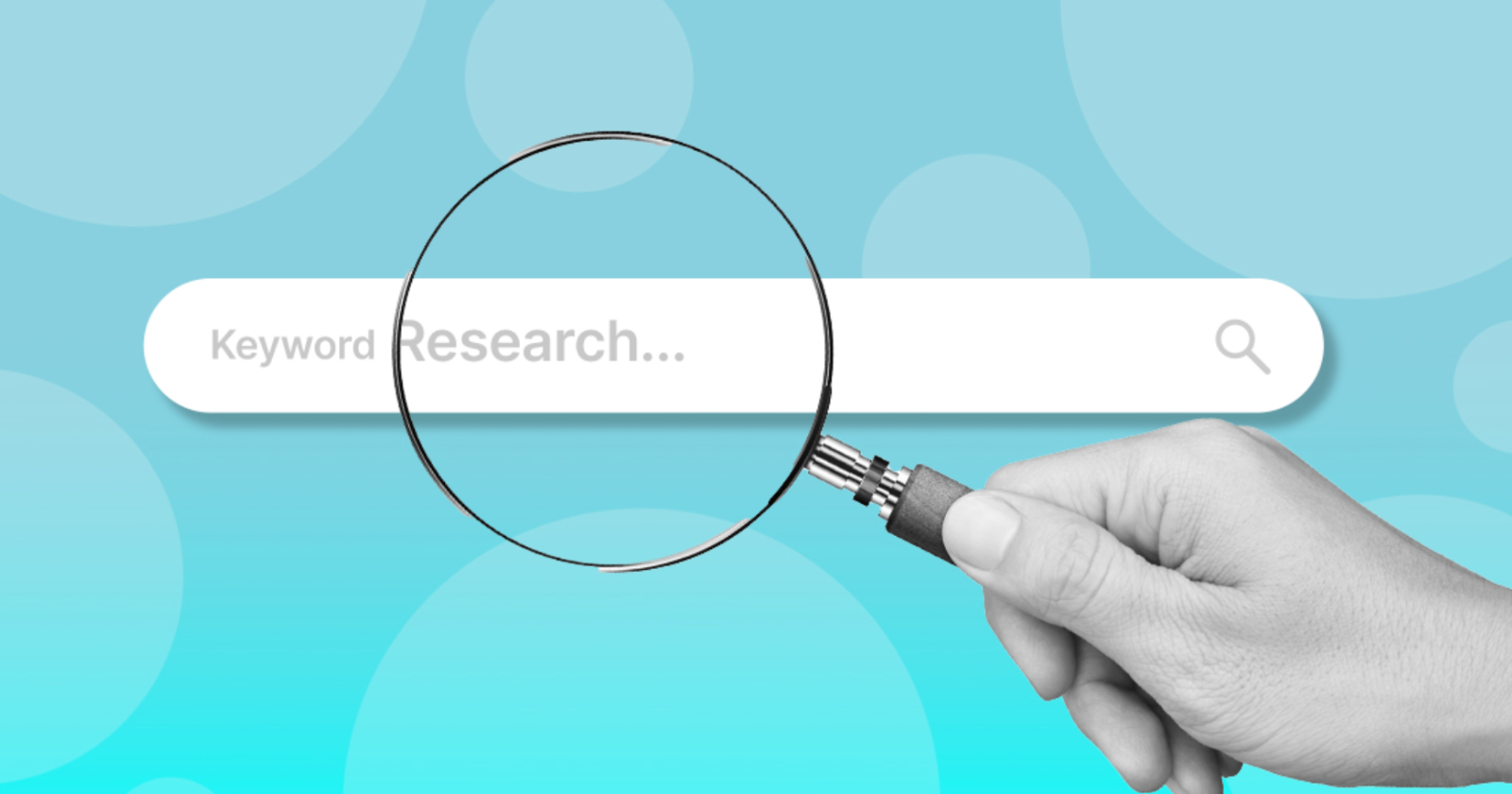
Keyword research is the foundation of search engine optimization, and without it, you cannot expect to create sustainable and repeatable visibility.
Today, SEO is a much wider discipline than in the early days of the industry and has been segmented into many verticals.
But, at the core, SEO is about finding opportunities online and capturing relevant traffic to a website through visibility in search engines. Keyword research is at the heart of that SEO strategy.
This guide explains what keyword research is, why it’s important, and how you can make a start for a successful SEO strategy.
What Is Keyword Research?
Keyword research is a process of finding words, queries, and phrases that users are searching for, which means a keyword that has search volume.
Research involves connecting the relevance of keywords to a website and its individual pages so that the user can find the best page to answer their query, known as search intent.
Keyword research also involves categorizing search queries into the different stages of a user journey and different categories of search, such as transactional, navigational, and informational.
Good keyword research enables users to find what they need:
- Shoppers who want to buy something can find the right product page.
- A user that wants to know ‘how to’ can find a page that explains a process in-depth.
- Users who want to research a person or brand can find out about that entity.
Keyword research should also carefully consider if ranking on a keyword is worth the effort it would take to rank highly and get visitors. Not all traffic is equal.
Download the ebook, How To Do Keyword Research For SEO .
Why Keyword Research Is Important For SEO
A search engine is an information retrieval system built around the queries that a user inputs to find an answer or relevant information to their search query.
The predominant focus of Google is to connect a user with the best answer to their query and the best website page so that a user is satisfied. Understanding this underlines SEO.
Good keyword research is the foundation of how a business can connect with its potential customers and audience. Understanding this helps to understand a good SEO strategy.
A business strategy starts with understanding its audience and their needs.
- What do they want?
- What do they need?
- What keeps them awake at night?
- What could solve their problem?
Keyword research is an extension of understanding your audience by first considering their needs and then the phrases, keywords, or queries they use to find solutions.
Keyword research is also important for SEO because it can show you where the opportunities are by knowing what your audience is searching for.
This will help you to find new areas of business and to prioritize where to focus attention and resources.
Keyword research will also help you to calculate where you can expect a return on investment to justify your efforts:
- Can a keyword deliver relevant traffic that has the possibility to convert to an end goal?
- What is an estimation of that traffic, and how much is each visitor worth to your business?
Basically, keyword research is the ultimate business research tool.
Read more: Why Keywords Are Still So Very Important For SEO
Keyword Research Basics
Monthly search volume.
Monthly Search Volume (MSV) is a predominant measure of keyword value. It’s a useful metric as a starting point to consider if anyone is searching for that keyword, but it shouldn’t be used in isolation or as the only measure of value.
Just because a keyword has a high MSV doesn’t mean it is the right keyword for you to rank on.
High-volume keywords generally deliver ‘browsing’ traffic at the top of the funnel. They are useful for brand awareness but not for direct conversion.
Low-volume keywords can be much more valuable because they can deliver users who are ready to buy a product.
Read more: A Complete Guide To Keyword Search Volume For SEO
User Intent
User intent refers to what type of result they want to see when they search for a query – the intention of their search.
You will hear user intent talked about a lot in keyword research, as it is one of the most important factors in the process.
User intent is important in two ways, firstly because your primary aim in creating content and pages on a website are to provide a user with information that they want to know.
There’s no point in creating a page about what you care about – your user only cares about their problems and needs.
You can have the best page in the world about the history of cupcakes, but if a user searching for [cupcake] wants a recipe for cupcakes, then they will not click on your link.
Secondly, Google considers relevance when serving results pages (as we said above, they want to deliver the best result for a query). So, the better your page fits user intent, the better it might rank.
Read more: How People Search: Understanding User Intent
When Google considers which pages it will show in search results, the algorithm will look at other pages that users are clicking on for that query.
If we have a query such as [cupcake], Google has to consider if a user wants to know what a cupcake is, how to make a cupcake, or wants to buy a cupcake.
By looking at a search result page, you can get a good idea of user intent from the other results.
Reviewing the search results page of a query should be part of your research process for every keyword you want to consider.
Keyword relevance and user intent are much the same things. It’s about knowing what the user really means when they search. This is more ambiguous for head keywords and less so for long-tail queries.
Long-Tail keywords
Long-tail keywords are called long-tail because they fall to the right of the search demand curve – where the graph looks like a long tail stretching to the right.
The search demand curve is a graph that shows keywords with high volume to the left and lower search volumes to the right.
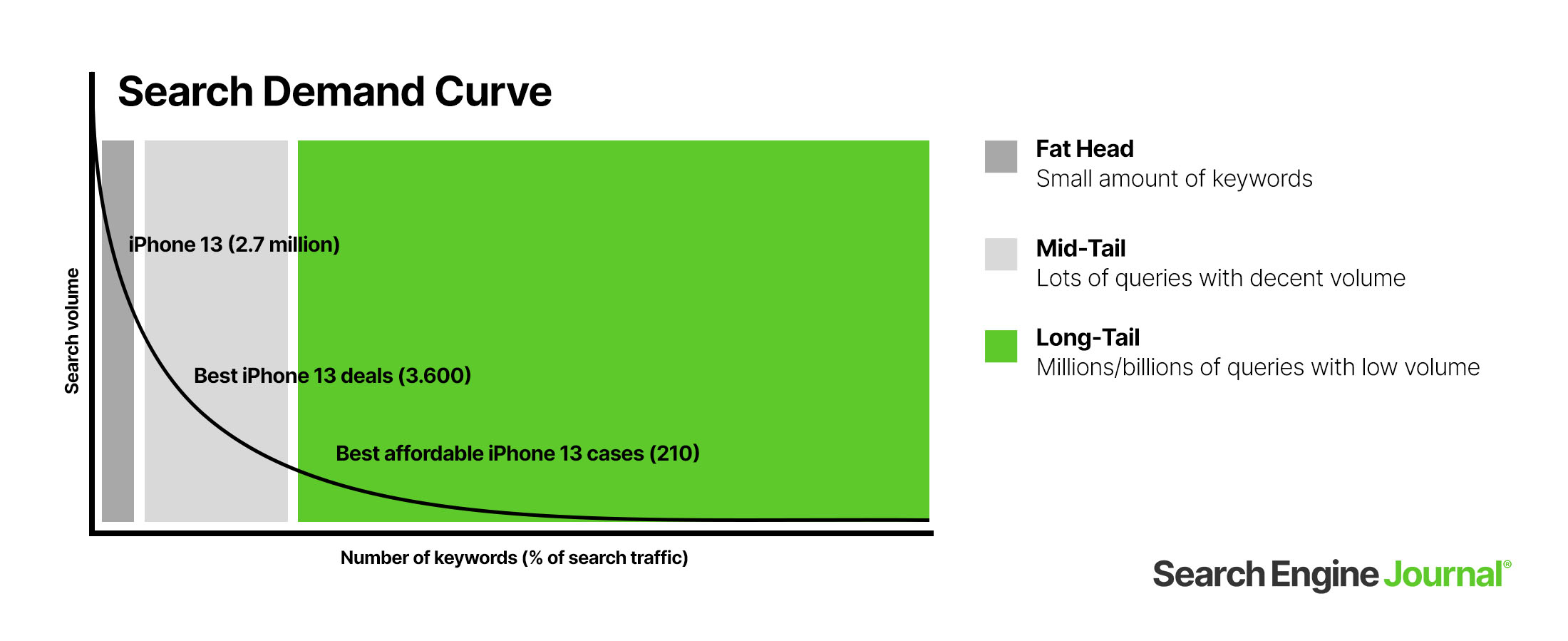
Longer queries that are more focused fall to the right. Head terms with broad meaning and high volume fall to the left.
The value of long-tail keywords is that they are usually highly focused terms that convert well, as users are actively looking for something very specific.
For example, [iPhone 13] is a head term with high volume (2.7 million MSV), and [Best affordable iPhone 13 cases] (210 MSV) is a long-tail keyword with far fewer searches but would have a high conversion rate.
Long-tail keywords are useful to include in a keyword strategy because they are usually much easier to rank for and achievable for a new website, and the cumulative volume of many long-tail keywords adds up to considerable targeted traffic.
This is a much more stable strategy than focusing on one high-volume ambiguous keyword.
Read more: Long-Tail Keyword Strategy: Why & How To Target Intent For SEO
Types Of Search Query
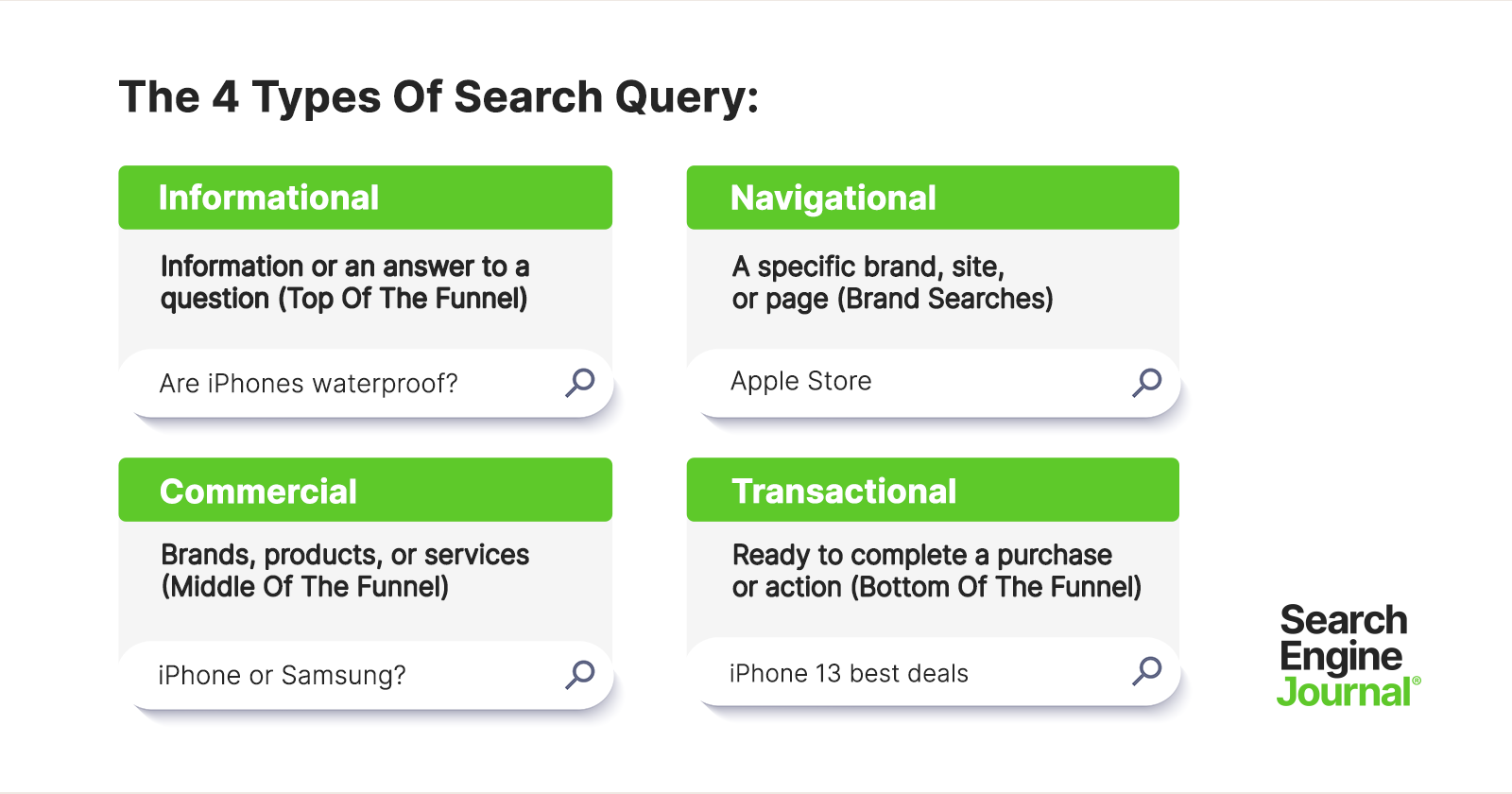
There are four types of keywords that are useful to understand as they categorize the different user intents and can help when planning a keyword strategy.
- Informational – users looking for information or an answer to a question (top of the funnel).
- Navigational – users wanting to find a specific brand, site, or page (brand searches).
- Commercial – users researching brands, products, or services (middle of the funnel).
- Transactional – users ready to complete a purchase or action (bottom of the funnel).
Local keywords can also be considered another category.
How To Do Keyword Research
Now that you have a better understanding of the basics of keyword research, we can look at where you would start with your research and keyword strategy.
1. How To Find Keyword Ideas
The first stage of keyword research is to brainstorm ideas for seed keywords, and there are several ways to do this.
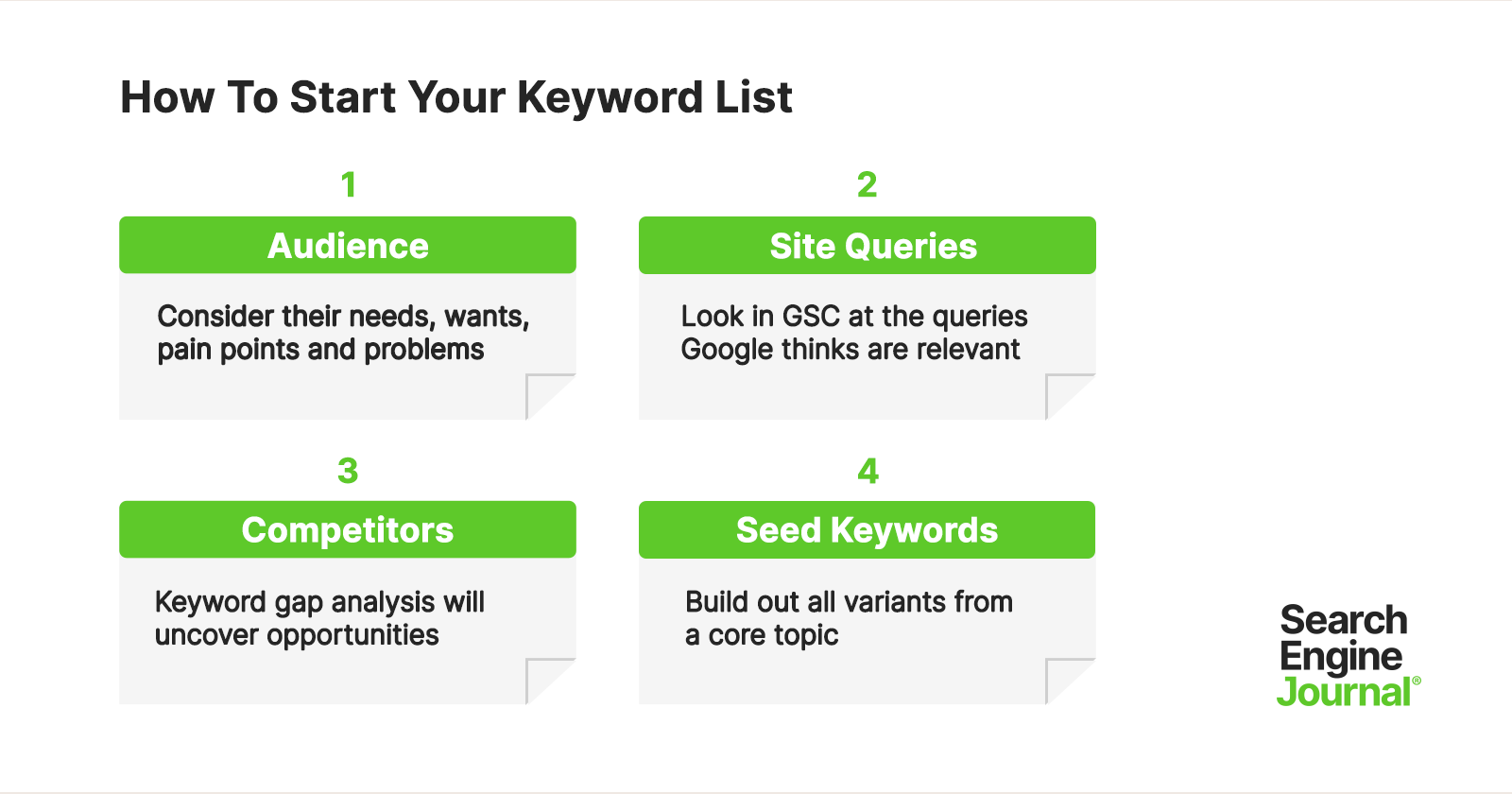
Your Target Audience
Everything starts with your audience and what they want. Think about their needs, wants, and especially their pain points and problems.
Start to compile your wide list of words, ideas, and topics that surround your niche or business.
Think About Questions
Question-based keyword queries are valuable as they can help you to capture featured snippets and can be a way to jump rank on highly competitive keywords.
Ask your sales team and review CRM data to find the questions that your audience is asking.
Also, think of question modifiers that will start to build out your list:
- What [is a road bike].
- How to [ride a road bike].
- When is [the best time to service a road bike].
- What is [the best road bike].
- Where is [road bike shop].
Current Site Queries
If your site already has some online history, then Google Search Console can tell you what Google thinks your website is relevant for. This is insightful to tell you if your site is conveying the right message and to find opportunities.
If Google is showing a lot of queries that have nothing to do with your product or brand, then you need to apply more keyword focus to your pages.
Look for queries that are position 10 or greater, have reasonable impressions, and you think are relevant to your business.
These are potential quick-win opportunities that you can capture by making improvements and optimizing pages for the query.
Read more: A Complete Google Search Console Guide For SEO Pros
Competitors’ Keywords
Your competitors are a gold mine of information because they might already have invested in extensive research.
A business should be constantly monitoring its competitors anyway, so keep an eye on what content they are producing and the terms they target.
A keyword gap analysis will help you find opportunities your competitors are targeting that you might not have considered.
Read more: Competitor Keyword Analysis: 5 Ways To Fill The Gaps In Your Organic Strategy & Get More Traffic
Seed Keywords
Start with high-level ‘seed’ keywords that you can use as a starting point to then open up variants and related queries.
Seed keywords are ‘big’ head terms such as [iPhone], [trainers], [road bike], or [cupcake].
For each seed keyword, start to think of topics that are related:
- Road bike maintenance.
- Road bike training.
- Road bike clothing.
- Road bike lights.
Also, use question modifiers and buying modifiers such as:
- Best [road bike].
- Buy [road bike].
- Price [for women’s road bike].
- [road bikes for hire] near me.
- Reviews [of road bikes under $1,000].
When you have finished this process, you should have a raw list of potential keywords grouped in topics – such as maintenance, clothing, training, etc.
2. How To Analyze Keywords
Once you have your raw list, it’s time to start to analyze and sort by value and opportunity.
Search Volume
Search volume will tell you if anyone is actively searching for this term.
For a first-stage strategy, you should aim for keywords with a mid-range and long-tail volume for quick wins and then build up to approach more competitive terms with higher volumes.
Head keywords with super high volumes (like ‘iPhone’) are not the best keywords to focus on as they can be too ambiguous and rarely have a specific intent.
Also, the amount of work that is needed to rank can be too high a barrier for entry unless you have an established domain of significant authority.
If a tool shows a keyword with zero search volume, this doesn’t always mean you should discard the term.
If the keyword is shown in the tool, then there can be value to consider targeting it in your strategy. However, make sure you know your audience and what is relevant to them before you invest resources in a zero-volume keyword.
Read more: Why You Should Target Zero Search Volume Keywords
Search Intent
After you have sorted your raw lists by search volumes, it’s then time to review the intent for each keyword that you would like to target.
The SERP will tell you everything that you need to know, and you should always review SERPs for clues on how to construct content and rank.
Look at the other listing that rank highly:
- Are they ‘how-to’ guides that indicate it’s informational?
- Do the titles say ‘buy,’ ‘best,’ or include product names?
- Is there a shopping carousel that indicates a buying keyword?
- Is there a location map that indicates it’s a local search?
Tag each keyword type and then consider which are the strongest keywords from each group.
You can also use a research tool that will tell you the type of keyword.
Topic Clusters
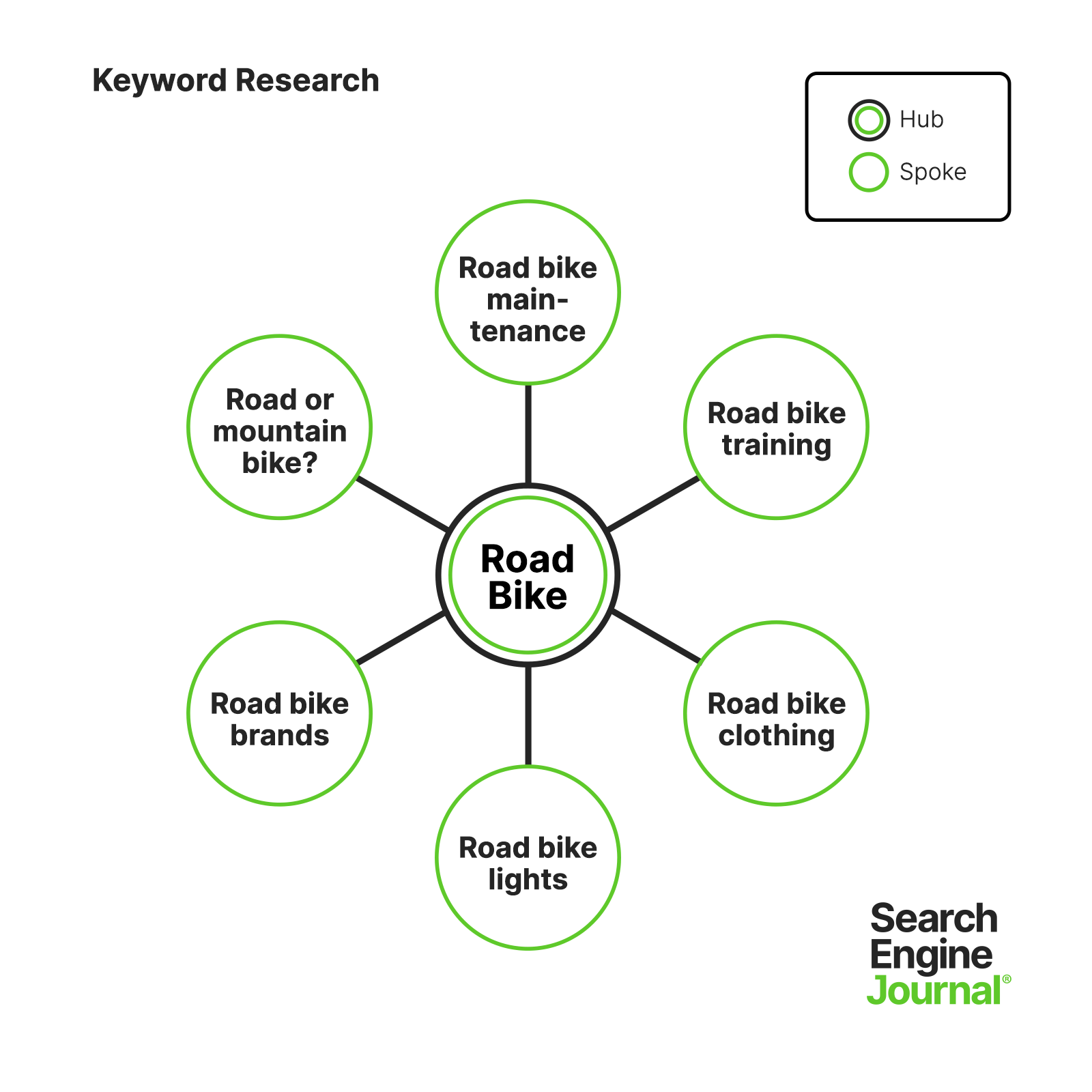
Grouping keywords into topic clusters is an advanced keyword strategy that can help to strengthen the topic authority of a site.
To do this, you would start with a high-volume head keyword and then research a series of keywords that supports that head term.
After creating pages of content that target each keyword, you use internal linking to connect pages with the same topic.
Read more: Keyword Clusters: How To Level Up Your SEO Content Strategy
3. How To Choose Organic Keywords
After sorting the volumes, intent, and topics, you will need to decide if you have a chance of ranking on a term by looking at how much competition there is for each keyword.
Keyword Difficulty
Keyword difficulty is one of the most important keyword metrics when doing your research.
If a keyword is so competitive that you need hundreds of thousands of dollars to rank, then you need to get strategic.
The easiest way to calculate keyword difficulty is to use a research tool that gives a score for each keyword.
Or, you can refer to Google Keyword Planner Tool and look at the CPC and level of difficulty. The higher the CPC bid, the higher the competition.
If you are starting out, first approach the lower competition keywords that are achievable and then build your way up to more competitive terms.
Read more: Why Keyword Research Is Useful For SEO & How To Rank
Connecting To Your Objectives And Goals
Unless a keyword can actually deliver a result for you – do you want to target it?
As we said above, targeting head terms is not the best strategy as they will, at best, deliver browsing or drive-by visitors. Unless you are a big brand with a big budget that is aiming for brand awareness, this is not the best application of your resources and budget.
Choosing your keyword priority should start with what can give you the best return in the shortest time frame.
Good keyword research is not just about trying to target a high-volume popular keyword. A good keyword strategy is about finding the right keywords for your needs and outcome. Always keep that front and center.
Read more: How To Calculate ROI For SEO When Targeting A Set Of Keywords
Watch John Mueller talk about ranking for head keywords in this video from the 38:55 minute mark.
Using Keyword Research Tools
Doing your research without a tool is limited; for the most in-depth keyword research, you need help to find keyword opportunities you had not thought of.
The following keyword research tools are all free versions that you can start out with.
Google Keyword Planner
The original keyword tool has evolved over the years, but it still remains one of the best free keyword tools and a good starting point to find seed keywords and keyword ideas.
The Google tool is aligned with Google Ads, so the data is skewed towards paid ads but is still valuable for research.
You need a Google Ads account to access the tool. Google will try to force you to set up an active campaign, but you can access the account by setting up an account without a campaign.
Without a campaign running, you will only get limited search volumes displayed in ranges, but the tool is still useful for its suggestions of keyword ideas. If you have an active campaign, Google will show you the monthly search volume.
You can add up to 10 seed keywords and get a list of suggested keywords, and run competitor URLs in the tool to find keywords they are targeting. Doing this is a great place to start building out raw lists of keywords to work from.
Read more: How To Use Google Keyword Planner
Read more: 9 Creative Ways To Use Google’s Keyword Planner Tool
Google Trends
Google Trends offers data based on actual search query data. It doesn’t provide search volumes, but the data in Google trends can be compared with actual search volumes from other tools so you can get a comparative feel of what the actual volumes are.
Where Trends excels is to identify trending topics and subtopics in a niche and to find geographic search trends in a local area. Trends will recommend related keywords that are currently growing in popularity.
As part of a keyword strategy, this can show you where to focus resources and when to stop investing in terms.
Read more: How To Use Google Trends For SEO
Google Autocomplete
Previously known as Suggest, Autocomplete is integrated into the Google search box to help users complete their search with what Google calls ‘predictions.’
Google takes its predictions from common searches and trending searches.
As the suggestions are all variations around the topic you are typing, the results shown give you an insight into other related terms that users could be looking for.
Checking the predictions that Google provides in Autocomplete can help you find more variations and keywords to consider.
Read more: Google Autocomplete: A Complete SEO Guide
Answer The Public
Answer The Public is a powerful tool that scrapes data from Google Autocomplete and connects a seed keyword with a variety of modifiers to produce a list of variants.
Answer The Public will quickly provide a list of suggestions, especially based on questions that you can use as a raw list to then review.
Read more: More Free Keyword Research Tools
Paid Keyword Research Tools
Free keyword tools are great to get you started and to create raw lists of keywords that you can then drill into.
However, for the best results, you might want to invest in a paid competitive analysis tool that can help you get monthly search volume and keyword difficulty data.
Some tools will also help with assigning topics and clustering for more advanced keyword strategies.
Anyone who does keyword research in-depth or to an advanced level will have their own process. They will also use a variety of tools and a combination of paid and free resources to get the best results.
Read more: Best Keyword Research Tools
Advanced Keyword Strategies
Now that you have an understanding of how to get started with keyword research, experiment with a few different websites and niches. Doing the work yourself is the best way to learn.
Once you have a better understanding in practice, move into more advanced methods and strategies to take your keyword research to the next level.
Advanced Keyword Research
- B2B Keyword Research Done Right With Practical Examples
- Keyword Clusters: How To Level Up Your SEO Content Strategy
- Building A Keyword Strategy For Comparison Content
Featured Image: Paulo Bobita/Search Engine Journal
Shelley Walsh is the SEO Content Strategist at SEJ & produces the Pioneers, a series about the history of SEO ...
Subscribe To Our Newsletter.
Conquer your day with daily search marketing news.

How to Integrate Your Customer Journey Strategy and SEO Strategy
The customer journey has inexorably changed because of search engines and digital marketing. Customers touch base with search engines at multiple points on their way down your sales funnel. This makes SEO vital to make your brand more visible, so you can be found where customers are looking for the products or services you offer.
Unless your SEO strategy integrates with your customer journey strategy, your prospective customers won’t be able to find you, but SEO strategies are usually keyword focused and not focused on the buyer. This is a mistake.
In this blogpost, we look at how best you can integrate the two to make both strategies more effective.
What is the Customer Journey?
The customer journey is the sum of experiences prospects go through as they seek a product or service. It’s every interaction a prospective customer has with your brand, regardless of whether they become a patron or not.
The digital landscape has made the customer journey nonlinear and complicated. It typically has the following steps:
Awareness –> Consideration –> Conversion –> Post-conversion
At the awareness stage, you introduce your brand to someone seeking a solution for their needs. Customers then move to consideration or research, where they check out competitors, read reviews and consult with family and friends. Then comes conversion i.e. the point where they trust you enough to make a purchase. The post-conversion stage is dependent on your customer service management.
The entire customer journey has multiple points of interaction where you can deliver the information prospective customers need. What’s important is how you exert your influence to push the prospect from one stage to another.
Understanding the customer journey can help you develop effective marketing campaigns. When you know the route your customers take, you can understand their motivations, anticipate their needs and help them achieve their goals.
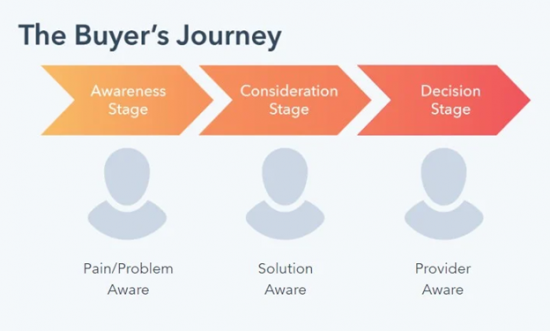
(Image source: https://blog.hubspot.com/marketing/content-for-every-funnel-stage)
How Does SEO Integrate with Customer Journey Strategy?
Search engines are the first place your target consumers will go when they have a need. In a survey, 48% of more than 14,000 online shoppers said they start their purchase journey on search engines.
Search engines help customers find you, but unfortunately, they help them find your competitors too. The one who comes out on top in the search rankings will be the one with the better SEO strategy.
Strong SEO can be your most powerful asset, turning intrigued prospects into paying customers. The right strategy will be designed while keeping the road the customer takes to push that coveted “buy” button in mind. Your SEO should assist the prospect as they move down the sales funnel, from first discovery to post-purchase.
Imagine you’re a business communication systems provider, and your most popular products are VoIP (voice over internet protocol) and a multi-line phone system for small business . Your target customers are companies with call centres.
You have to strategically devise your keyword strategy and create backlinks to your content. With effective SEO in place, you can also target prospects who are further down the marketing funnel.
With the communication systems provider example, you might create videos or infographics that provide customers with more information about your product and how it will resolve their problems. You need to match SEO keywords with customer intent.
Your SEO-driven landing page should have keywords related to VoIP for call centers .
The content should tell them your business value proposition and how VoIP could be game-changing for them.
Search engines have gotten smarter and want to answer people’s questions with high-quality content. Gone are the days of keyword stuffing and backlink strategies. Search engines are machines to answer questions and they give priority to websites that have relevant results for user queries.
The following points in your customer journey might involve an online search. There could be more, but these are the most common touchpoints:
- Product research
- Competitor analysis
- Price checking
- Delivery options
- Customer service
Let’s discuss in detail how you can incorporate SEO into all four stages of the customer journey:
At the awareness stage, you’re marketing your brand. As part of your SaaS marketing plan (if we stick with the business communication systems provider example above), SEO can have a big impact on prospective customers.
Prospects might have heard of you from a friend or social media. You should also try to appear in the search results when they Google VoIP or multi-line phone systems.
Repurpose your content as per your keyword research so you show up at the top of targeted search results. Get your website optimized for search engines and know what your prospects are searching for through effective keyword (and long-tail keyword) research. Be consistent with your SEO efforts to expand and improve search rankings.
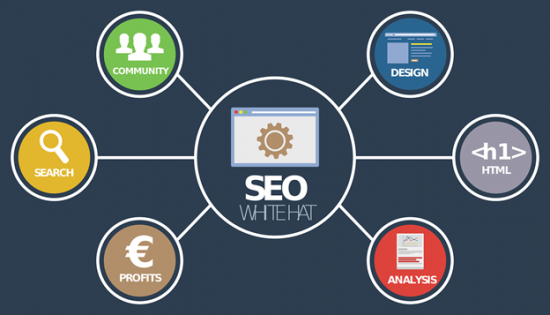
(Image source: https://pixabay.com/vectors/seo-online-analysis-1327870/)
Consideration
At this stage, customers are searching for specific ways to fix problems. Here your FAQs page is an important tool. Your content needs to answer questions your customers might have to build trust.
Along with an FAQs page, you can incorporate other persuasive content in the form of blogs and articles showing how your product is better than competitors. All this needs to be part of your wider SEO strategy .
For a prospect that’s further down the funnel and comparing your offerings with those of a competitor, use relevant keywords that objectively explain why you’re better.
It’s wise to take advantage of the SEO on digital platforms like directories or listing sites. If your customers leave reviews on Google My Business and Yelp, these will rank highly in search results and give prospects the social proof they need to trust you.
Google reviews impact SEO rankings and have a massive effect on converting potential customers. You can push the prospect toward conversion by using videos for testimonials, case studies, and product demos, and also by ensuring your website’s UI and UX help the customer to navigate it.
eCommerce personalisation can also assist your SEO strategy, ensuring you deliver a personalized experience and engage customers by showing content based on previous actions, browsing behavior, purchase history, and demographic.
Your prospects have recognized their problem and now they need help fixing it. They’re on the brink of making a decision, and you need to lead them to it.
At this point, you have to catch searches specific to purchase intent. For example, demonstrating your product is deliverable to a certain area or your service is available in a particular city. Keyword searches related to the price – e.g. “lowest price [insert your product/service]” are also common and should be part of your content strategy if applicable to your product/service.
Providing the right content at the correct time on your web pages can help with educating the customer and have a major influence on buying decisions. Make use of videos and infographics to further the customer education process and nurture your leads to purchase.
Post-conversion
Your customer has made a purchase, and now you need to ensure you retain their custom. Your content needs to continue offering value and help them get the most out of your products and services as they look for follow-up support.
Your existing customers might search for you time and again, so have content for returning customers that’s relevant to this phase. SEO can help keep your customers loyal in the long term.
You need to request reviews that will loop back and strengthen your SEO during the consideration phase. These are also important for improvement and customer service.
Always respond to reviews, especially negative ones. Testimonials on your social media and review websites are another form of content that can drive traffic.
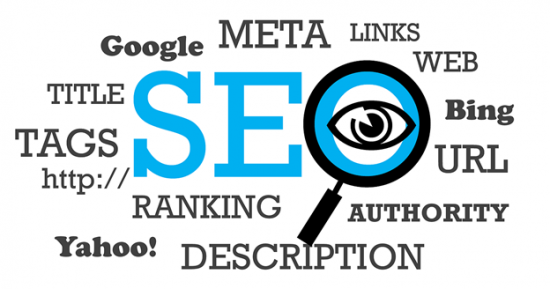
(Image source: https://pixabay.com/illustrations/seo-google-search-engine-896175/)
How Do You Know Your Customer Journey SEO Strategy is working?
SEO is an integral part of any digital marketing strategy, and there are many ways to monitor the performance of your SEO experiments . Mapping the customer journey and developing content and keywords around it will bring steady results for your business. You should be monitoring and tracking your performance using the analytical tools provided by search engines.
The customer journey framework plays a big role in understanding your target market. Mapping this provides a picture of how people are searching at each stage. This helps you create content that’s targeted to the individual needs of the customer depending on where they are in their journey. Such personalized, targeted content can help you rank more highly on search engine results pages.
Your entire team needs to be focused and committed to creating strong SEO throughout the customer journey. This won’t only help your site to rank better but allow you to craft content that addresses the questions and pain points of your audience at different, meaningful touchpoints throughout your sales funnel.
Looking for some advice on how to improve your SEO strategy? Then get in touch! Our Digital Strategies Group experts will be happy to help!
Please contact us
Customer Journey Maps: How to Create Really Good Ones [Examples + Template]
Updated: April 17, 2024
Published: May 04, 2023
Did you know 70% of online shoppers abandoned their carts in 2022? Why would someone spend time adding products to their cart just to fall off the customer journey map at the last second?

The thing is — understanding your customer base can be very challenging. Even when you think you’ve got a good read on them, the journey from awareness to purchase for each customer will always be unpredictable, at least to some level.

While it isn’t possible to predict every experience with 100% accuracy, customer journey mapping is a convenient tool for keeping track of critical milestones that every customer hits. In this post, I’ll explain everything you need to know about customer journey mapping — what it is, how to create one, and best practices.
Table of Contents
What is the customer journey?
What is a customer journey map, benefits of customer journey mapping, customer journey stages.
- What’s included in a customer journey map?
The Customer Journey Mapping Process
Steps for creating a customer journey map.
- Types of Customer Journey Maps
Customer Journey Mapping Best Practices
- Customer Journey Design
- Customer Journey Map Examples
Free Customer Journey Map Templates
.webp)
Free Customer Journey Template
Outline your company's customer journey and experience with these 7 free templates.
- Buyer's Journey Template
- Future State Template
- Day-in-the-Life Template
You're all set!
Click this link to access this resource at any time.
The customer journey is the series of interactions a customer has with a brand, product, or business as they become aware of a pain point and make a purchase decision. While the buyer’s journey refers to the general process of arriving at a purchase, the customer journey refers to a buyer's purchasing experience with a specific company or service.
Customer Journey vs. Buyer Journey
Many businesses that I’ve worked with were confused about the differences between the customer’s journey and the buyer’s journey. The buyer’s journey is the entire buying experience from pre-purchase to post-purchase. It covers the path from customer awareness to becoming a product or service user.
In other words, buyers don’t wake up and decide to buy on a whim. They go through a process of considering, evaluating, and purchasing a new product or service.
The customer journey refers to your brand’s place within the buyer’s journey. These are the customer touchpoints where you will meet your customers as they go through the stages of the buyer’s journey. When you create a customer journey map, you’re taking control of every touchpoint at every stage of the journey instead of leaving it up to chance.
For example, at HubSpot, our customer’s journey is divided into three stages — pre-purchase/sales, onboarding/migration, and normal use/renewal.


What is UX journey mapping?
A UX journey map represents how a customer experiences their journey toward achieving a specific goal or completing a particular action.
For example, the term “UX journey mapping” can be used interchangeably with the term “customer journey mapping” if the goal being tracked is the user’s journey toward purchasing a product or service.
However, UX journey mapping can also be used to map the journey (i.e., actions taken) towards other goals, such as using a specific product feature.
Why is customer journey mapping important?
While the customer journey might seem straightforward — the company offers a product or service, and customers buy it — for most businesses, it typically isn’t.
In reality, it’s a complex journey that begins when the customer becomes problem-aware (which might be long before they become product-aware) and then moves through an intricate process of further awareness, consideration, and decision-making.
The customer is also exposed to multiple external factors (competitor ads, reviews, etc.) and touchpoints with the company (conversations with sales reps, interacting with content, viewing product demos, etc.).
Keep in mind that 80% of customers consider their experience with a company to be as important as its products.
By mapping this journey, your marketing, sales, and service teams can understand, visualize, and gain insight into each stage of the process.
You can then decrease friction along the way and make the journey as helpful and delightful as possible for your leads and customers. Customer journey mapping allows you to understand your customers’ motivations, pain points, and needs — resulting in an increased ability to provide solutions. Customers are 2.4x more likely to stick with a brand when their problems are solved quickly, so don’t miss out on the power of customers.
What data is necessary for customer journey mapping?
Your customer journey map isn’t just a guess based on how you think customers interact with your brand. It’s a data-driven, research-based operation that analyzes past customer behavior. So, what data should you be looking at?
Customer Surveys and Interviews
What better way to find out how customers think than to ask them? Customer surveys and interviews will provide first-hand information about the stage of the customer journey, their pain points, and how they use your products to solve their problems.
Surveys and interviews are referred to as Solicited Data because you have to specifically ask customers to fill out a questionnaire and provide data. Consider sending an NPS Survey to customers or asking for feedback on social media to gather the solicited data necessary for customer journey mapping. However, surveys and interviews won’t tell the whole story. That’s where unsolicited data comes in.
Unsolicited Data
Unsolicited data refers to all the data you collect from customers without specifically prompting them. Data points like purchase history, time spent on page, email clicks, page views, feedback from your support team, call/chat transcripts, and much more will fill in the gaps in your customer journey mapping strategy.
Unsolicited data is instrumental and much more plentiful than solicited data. While only a small number of customers will respond to surveys and questionnaires, you can collect valuable data on every customer who interacts with your brand to bolster the effectiveness and accuracy of your customer journey map.
Breaking down the customer journey, phase by phase, aligning each step with a goal, and restructuring your touchpoints accordingly are essential steps for maximizing customer success.
Here are a few more benefits to gain from customer journey mapping.
1. You can refocus your company with an inbound perspective.
Rather than discovering customers through outbound marketing, you can have your customers find you with the help of inbound marketing.
Outbound marketing involves tactics targeted at generalized or uninterested audiences and seeks to interrupt prospects’ daily lives. Outbound marketing is costly and inefficient. It annoys and deters customers and prospects.
Inbound marketing involves creating helpful content that customers are already looking for. You grab their attention first and focus on the sales later.
By mapping out the customer journey, you can understand what’s interesting and helpful to your customers and what’s turning them away.
2. You can create a new target customer base.
You need to understand the customer journey properly to understand your customers’ demographics and psychographics.
It’s a waste of time and money to repeatedly target too broad of an audience rather than people who are actually interested in your offering.
Researching the needs and pain points of your typical customers will give you a good picture of the kinds of people who are trying to achieve a goal with your company. Thus, you can hone your marketing to that specific audience.
3. You can implement proactive customer service.
A customer journey map is like a roadmap to the customer experience.
It highlights moments where people experience delight and situations where they might face friction. Knowing this beforehand lets you plan your customer service strategy and intervene at ideal times.
Proactive customer service also makes your brand appear more reliable. For example, when I worked in customer support, we would anticipate a surge in tickets around the holidays. To be proactive, we’d send out a message to customers letting them know about our team’s adjusted holiday hours. We would also tell them about additional support options if we were unavailable and what to do if an urgent problem needed immediate attention.
With expectations set, customers won’t feel surprised if they’re waiting on hold a little longer than usual. They’ll even have alternative options to choose from — like a chatbot or knowledge base — if they need to find a faster solution.
4. You can improve your customer retention rate.
When you have a complete view of the customer journey, it’s easier to identify areas for improvement. When you do, customers experience fewer pain points, leading to fewer people leaving your brand for competitors.
After all, 33% of customers will consider switching brands after just one poor experience.
Customer journey mapping can point out individuals on the path to churn. If you log the common behaviors of these customers, you can start to spot them before they leave your business.
While you might not save them all, it’s worth the try. Increasing customer retention rates by just 5% can increase profits by 25%-95%.
5. You can create a customer-focused mentality throughout the company.
As your company grows, it can be tricky to coordinate all your departments to be as customer-focused as your customer service, support, and success teams. That’s because each department has varying goals, meaning they might not prioritize customer needs — they might focus on website traffic, leads, product signups, etc.
One way to overcome this data silo is to share a clear customer journey map with your entire organization. The great thing about these maps is that they map every step of the customer journey, from initial attraction to post-purchase support. And, yes, this concerns marketing, sales, and service.
Now that we’ve discussed the customer journey and the benefits of mapping it, let’s review the specific stages that comprise it.
Generally, there are five phases that customers go through when interacting with a brand or a product: Awareness, Consideration, Decision, Retention, and Loyalty.

1. Use customer journey map templates.
Why make a customer journey map from scratch when you can use a template? Save yourself some time by downloading HubSpot’s free customer journey map templates .
This has templates that map out a buyer’s journey, a day in your customer’s life, lead nurturing, and more.
These templates can help sales, marketing, and customer support teams learn more about your company’s buyer persona. This will improve your product and customer experience.
2. Set clear objectives for the map.
Before you dive into your customer journey map, you need to ask yourself why you’re creating one in the first place.
What goals are you directing this map towards? Who is it for? What experience is it based upon?
If you don’t have one, I recommend creating a buyer persona . This persona is a fictitious customer with all the demographics and psychographics of your average customer. This persona reminds you to direct every aspect of your customer journey map toward the right audience.
3. Profile your personas and define their goals.
Next, you should conduct research. This is where it helps to have customer journey analytics ready.
Don’t have them? No worries. You can check out HubSpot’s Customer Journey Analytics tool to get started.
Questionnaires and user testing are great ways to obtain valuable customer feedback. The important thing is to only contact actual customers or prospects.
You want feedback from people interested in purchasing your products and services who have either interacted with your company or plan to do so.
Some examples of good questions to ask are:
- How did you hear about our company?
- What first attracted you to our website?
- What are the goals you want to achieve with our company? In other words, what problems are you trying to solve?
- How long have you/do you typically spend on our website?
- Have you ever made a purchase with us? If so, what was your deciding factor?
- Have you ever interacted with our website to make a purchase but decided not to? If so, what led you to this decision?
- On a scale of 1 to 10, how easily can you navigate our website?
- Did you ever require customer support? If so, how helpful was it, on a scale of 1 to 10?
- Can we further support you to make your process easier?
You can use this buyer persona tool to fill in the details you procure from customer feedback.
4. Highlight your target customer personas.
Once you’ve learned about the customer personas that interact with your business, I recommend narrowing your focus to one or two.
Remember, a customer journey map tracks the experience of a customer taking a particular path with your company. If you group too many personas into one journey, your map won’t accurately reflect that experience.
When creating your first map, it’s best to pick your most common customer persona and consider the route they would typically take when engaging with your business for the first time.
You can use a marketing dashboard to compare each and determine the best fit for your journey map. Don’t worry about the ones you leave out, as you can always go back and create a new map specific to those customer types.
5. List out all touchpoints.
Begin by listing the touchpoints on your website.
What is a touchpoint in a customer journey map?
A touchpoint in a customer journey map is an instance where your customer can form an opinion of your business. You can find touchpoints in places where your business comes in direct contact with a potential or existing customer.
For example, if I were to view a display ad, interact with an employee, reach a 404 error, or leave a Google review, all of those interactions would be considered a customer touchpoint.
Your brand exists beyond your website and marketing materials, so you must consider the different types of touchpoints in your customer journey map. These touchpoints can help uncover opportunities for improvement in the buying journey.
Based on your research, you should have a list of all the touchpoints your customers are currently using and the ones you believe they should be using if there’s no overlap.
This is essential in creating a customer journey map because it provides insight into your customers’ actions.
For instance, if they use fewer touchpoints than expected, does this mean they’re quickly getting turned away and leaving your site early? If they are using more than expected, does this mean your website is complicated and requires several steps to reach an end goal?
Whatever the case, understanding touchpoints help you understand the ease or difficulties of the customer journey.
Aside from your website, you must also look at how your customers might find you online. These channels might include:
- Social channels.
- Email marketing.
- Third-party review sites or mentions.
Run a quick Google search of your brand to see all the pages that mention you. Verify these by checking your Google Analytics to see where your traffic is coming from. Whittle your list down to those touchpoints that are the most common and will be most likely to see an action associated with it.
At HubSpot, we hosted workshops where employees from all over the company highlighted instances where our product, service, or brand impacted a customer. Those moments were recorded and logged as touchpoints. This showed us multiple areas of our customer journey where our communication was inconsistent.
The proof is in the pudding — you can see us literally mapping these touch points out with sticky notes in the image below.

Don't forget to share this post!
Related articles.
![journey keywords How AI Image Misuse Made a World of Miscommunication [Willy's Chocolate Experience]](https://blog.hubspot.com/hubfs/ai%20image%20misuse%20the%20willy%20wonka%20experience%20%281%29.png)
How AI Image Misuse Made a World of Miscommunication [Willy's Chocolate Experience]

7 Ways to Delight Your Customers This Holiday Season

14 Customer Experience Fails that Companies Can Learn From
![journey keywords How Customer Experience Has Evolved Over the Last Decade [+ 2024 Trends]](https://blog.hubspot.com/hubfs/future-of-customer-experience.png)
How Customer Experience Has Evolved Over the Last Decade [+ 2024 Trends]
![journey keywords Memorable Examples of AR in Customer Experience [+Tips for Implementing the Technology]](https://blog.hubspot.com/hubfs/augmented%20reality%20customer%20experience.png)
Memorable Examples of AR in Customer Experience [+Tips for Implementing the Technology]

Digital Customer Experience: The Ultimate Guide for 2023
![journey keywords How to Implement a Hybrid Customer Service Strategy That Works [Expert Tips]](https://blog.hubspot.com/hubfs/hybrid%20customer%20service_featured.png)
How to Implement a Hybrid Customer Service Strategy That Works [Expert Tips]

User Flows: 8 Tips For Creating A Super Smooth User Experience

11 Best Practices for B2B Customer Experience
![journey keywords Customer Experience vs. User Experience: What’s the Difference? [+ Examples]](https://blog.hubspot.com/hubfs/customer-experience-vs-user-experience_2.webp)
Customer Experience vs. User Experience: What’s the Difference? [+ Examples]
Outline your company's customer journey and experience with these 7 free customer journey map templates.
Service Hub provides everything you need to delight and retain customers while supporting the success of your whole front office
Journey Words
Words related to journey.
Below is a massive list of journey words - that is, words related to journey. The top 4 are: travel , trip , story and excursion . You can get the definition(s) of a word in the list below by tapping the question-mark icon next to it. The words at the top of the list are the ones most associated with journey, and as you go down the relatedness becomes more slight. By default, the words are sorted by relevance/relatedness, but you can also get the most common journey terms by using the menu below, and there's also the option to sort the words alphabetically so you can get journey words starting with a particular letter. You can also filter the word list so it only shows words that are also related to another word of your choosing. So for example, you could enter "travel" and click "filter", and it'd give you words that are related to journey and travel.
You can highlight the terms by the frequency with which they occur in the written English language using the menu below. The frequency data is extracted from the English Wikipedia corpus, and updated regularly. If you just care about the words' direct semantic similarity to journey, then there's probably no need for this.
There are already a bunch of websites on the net that help you find synonyms for various words, but only a handful that help you find related , or even loosely associated words. So although you might see some synonyms of journey in the list below, many of the words below will have other relationships with journey - you could see a word with the exact opposite meaning in the word list, for example. So it's the sort of list that would be useful for helping you build a journey vocabulary list, or just a general journey word list for whatever purpose, but it's not necessarily going to be useful if you're looking for words that mean the same thing as journey (though it still might be handy for that).
If you're looking for names related to journey (e.g. business names, or pet names), this page might help you come up with ideas. The results below obviously aren't all going to be applicable for the actual name of your pet/blog/startup/etc., but hopefully they get your mind working and help you see the links between various concepts. If your pet/blog/etc. has something to do with journey, then it's obviously a good idea to use concepts or words to do with journey.
If you don't find what you're looking for in the list below, or if there's some sort of bug and it's not displaying journey related words, please send me feedback using this page. Thanks for using the site - I hope it is useful to you! 🐽

- circumnavigation
- adventurers
- arrive at destination
- destination
- experiences
- peregrination
- pilgrimages
- go back home
- perambulation
- whirlwind tour
- circuitous route
- rollercoaster ride
- arduous journey
- relationship
- roller coaster ride
- exploration
- expeditions
- development
- perspective
- disembarking
- progression
- transformation
- misadventures
- magic carpet
- peregrinate
- hypertravel
- cybertravel
- united states
- approaching
- round trip ticket
- see new place
- buy souvenir
- lose something
- cosmopolitan
- experience different culture
- pilgrim's journey
- pleasure trip
- book holiday
- visit other country
- motion sickness
- choose destination
- thoroughfare
- metamorphosis
- explorations
- thanatourism
- hand luggage
- intercontinental
- go to airport
- circumnavigate
- plane ticket
- business trip
- go someplace
- road warrior
- passenger ticket
- kilometrage
- rollercoaster
- transcontinental
- mode of transport
- go somewhere
- change of location
- return ticket
- get on plane
- toll highway
- save your money
- amphidromous
- fly in airplane
- learn foreign language
- bedroom community
- spring break
- board plane
- get somewhere
- head for hill
- county highway
- train ticket
- visit relative
- fellow traveller
- between deck
- reverse commuter
- hang around
- action potential
- reach destination
- return home
- satchel bag
- subway token
- time space convergence
- learn new language
- transit ticket
- take picture
- drive your car
- you be curious
- right of reentry
- travel quickly
- heavy metal music
- standard fare
- bharat army
- space travel
- shoulder season
- intradirective verb
- freedom of movement
- time travel
- reverse commute
- drake passage
- via dolorosa
- caledonian canal
- maiden voyage
That's about all the journey related words we've got! I hope this list of journey terms was useful to you in some way or another. The words down here at the bottom of the list will be in some way associated with journey, but perhaps tenuously (if you've currenly got it sorted by relevance, that is). If you have any feedback for the site, please share it here , but please note this is only a hobby project, so I may not be able to make regular updates to the site. Have a nice day! 🐥

- Children's Books
- Arts, Music & Photography

Enjoy fast, free delivery, exclusive deals, and award-winning movies & TV shows with Prime Try Prime and start saving today with fast, free delivery
Amazon Prime includes:
Fast, FREE Delivery is available to Prime members. To join, select "Try Amazon Prime and start saving today with Fast, FREE Delivery" below the Add to Cart button.
- Cardmembers earn 5% Back at Amazon.com with a Prime Credit Card.
- Unlimited Free Two-Day Delivery
- Streaming of thousands of movies and TV shows with limited ads on Prime Video.
- A Kindle book to borrow for free each month - with no due dates
- Listen to over 2 million songs and hundreds of playlists
- Unlimited photo storage with anywhere access
Important: Your credit card will NOT be charged when you start your free trial or if you cancel during the trial period. If you're happy with Amazon Prime, do nothing. At the end of the free trial, your membership will automatically upgrade to a monthly membership.
Buy new: $11.58 $11.58 FREE delivery Saturday, May 4 on orders shipped by Amazon over $35 Ships from: Amazon.com Sold by: Amazon.com
Return this item for free.
Free returns are available for the shipping address you chose. You can return the item for any reason in new and unused condition: no shipping charges
- Go to your orders and start the return
- Select the return method
Buy used: $7.49
Fulfillment by Amazon (FBA) is a service we offer sellers that lets them store their products in Amazon's fulfillment centers, and we directly pack, ship, and provide customer service for these products. Something we hope you'll especially enjoy: FBA items qualify for FREE Shipping and Amazon Prime.
If you're a seller, Fulfillment by Amazon can help you grow your business. Learn more about the program.

Download the free Kindle app and start reading Kindle books instantly on your smartphone, tablet, or computer - no Kindle device required .
Read instantly on your browser with Kindle for Web.
Using your mobile phone camera - scan the code below and download the Kindle app.

Image Unavailable

- To view this video download Flash Player

Follow the author

Journey (Aaron Becker's Wordless Trilogy, 1) Hardcover – Picture Book, August 6, 2013
Purchase options and add-ons.
- Book 1 of 3 Journey Trilogy
- Print length 40 pages
- Language English
- Grade level Preschool - 3
- Lexile measure NP
- Dimensions 11 x 0.39 x 9.63 inches
- Publisher Candlewick
- Publication date August 6, 2013
- ISBN-10 0763660531
- ISBN-13 978-0763660536
- See all details
Frequently bought together

More items to explore

From the Publisher

"A masterwork."
— The New York Times
Editorial Reviews
Amazon.com review, from school library journal, from booklist, about the author, product details.
- Publisher : Candlewick; 1st edition (August 6, 2013)
- Language : English
- Hardcover : 40 pages
- ISBN-10 : 0763660531
- ISBN-13 : 978-0763660536
- Reading age : 3 - 6 years, from customers
- Lexile measure : NP
- Grade level : Preschool - 3
- Item Weight : 1.1 pounds
- Dimensions : 11 x 0.39 x 9.63 inches
- #831 in Children's Friendship Books
- #997 in Children's Fantasy & Magic Books
- #1,249 in Children's Action & Adventure Books (Books)
Videos for this product

Click to play video

Book Talk: Journey by Aaron Becker
Must Watch Before You Buy

Journey (Aaron Becker's Wordless Trilogy)
Merchant Video
About the author
Aaron becker.
Born in Baltimore, Aaron Becker moved to California to attend Pomona College where he scored his first illustration job designing t-shirts for his water polo team. Since then, he's traveled to Kenya, Japan, Sweden, and Tahiti backpacking around while looking for good things to eat and feeding his imagination. He now lives with his family in Amherst, MA where he's busy at work on his next book project. You can find out more about what he's been up to lately at storybreathing.com.
Customer reviews
Customer Reviews, including Product Star Ratings help customers to learn more about the product and decide whether it is the right product for them.
To calculate the overall star rating and percentage breakdown by star, we don’t use a simple average. Instead, our system considers things like how recent a review is and if the reviewer bought the item on Amazon. It also analyzed reviews to verify trustworthiness.
Reviews with images

- Sort reviews by Top reviews Most recent Top reviews
Top reviews from the United States
There was a problem filtering reviews right now. please try again later..
Top reviews from other countries
- Amazon Newsletter
- About Amazon
- Accessibility
- Sustainability
- Press Center
- Investor Relations
- Amazon Devices
- Amazon Science
- Sell on Amazon
- Sell apps on Amazon
- Supply to Amazon
- Protect & Build Your Brand
- Become an Affiliate
- Become a Delivery Driver
- Start a Package Delivery Business
- Advertise Your Products
- Self-Publish with Us
- Become an Amazon Hub Partner
- › See More Ways to Make Money
- Amazon Visa
- Amazon Store Card
- Amazon Secured Card
- Amazon Business Card
- Shop with Points
- Credit Card Marketplace
- Reload Your Balance
- Amazon Currency Converter
- Your Account
- Your Orders
- Shipping Rates & Policies
- Amazon Prime
- Returns & Replacements
- Manage Your Content and Devices
- Recalls and Product Safety Alerts
- Conditions of Use
- Privacy Notice
- Consumer Health Data Privacy Disclosure
- Your Ads Privacy Choices

- Appointments

- Resume Reviews

- Undergraduates
- PhDs & Postdocs
- Faculty & Staff
- Prospective Students
- Online Students
- Career Champions
- I’m Exploring
- Architecture & Design
- Education & Academia
- Engineering
- Fashion, Retail & Consumer Products
- Fellowships & Gap Year
- Fine Arts, Performing Arts, & Music
- Government, Law & Public Policy
- Healthcare & Public Health
- International Relations & NGOs
- Life & Physical Sciences
- Marketing, Advertising & Public Relations
- Media, Journalism & Entertainment
- Non-Profits
- Pre-Health, Pre-Law and Pre-Grad
- Real Estate, Accounting, & Insurance
- Social Work & Human Services
- Sports & Hospitality
- Startups, Entrepreneurship & Freelancing
- Sustainability, Energy & Conservation
- Technology, Data & Analytics
- DACA and Undocumented Students
- First Generation and Low Income Students
- International Students
- LGBTQ+ Students
- Transfer Students
- Students of Color
- Students with Disabilities
- Explore Careers & Industries
- Make Connections & Network
- Search for a Job or Internship
- Write a Resume/CV
- Write a Cover Letter
- Engage with Employers
- Research Salaries & Negotiate Offers
- Find Funding
- Develop Professional and Leadership Skills
- Apply to Graduate School
- Apply to Health Professions School
- Apply to Law School
- Self-Assessment
- Experiences
- Post-Graduate
- Jobs & Internships
- Career Fairs
- For Employers
- Meet the Team
- Peer Career Advisors
- Social Media
- Career Services Policies
- Walk-Ins & Pop-Ins
- Strategic Plan 2022-2025
From Class to Clinic – My Nursing Journey at NYU Langone
- Share This: Share From Class to Clinic – My Nursing Journey at NYU Langone on Facebook Share From Class to Clinic – My Nursing Journey at NYU Langone on LinkedIn Share From Class to Clinic – My Nursing Journey at NYU Langone on X

Daisy Tso, NUR ’24, Staten Island, NY
This summer, I had the amazing opportunity to work as a student nurse extern at NYU Langone Hospital in Manhattan. Working as a student nurse extern has been an enriching experience that deepened my understanding of nursing care. I was able to apply what I have learned so far in nursing school. During this externship, I had the privilege of shadowing a seasoned nurse on a Medicine unit for 8 weeks, where I learned several hands-on skills such as inserting peripheral IV catheters, drawing blood, and inserting Foley catheters. There were always opportunities to learn and grow. One nursing skill that I had the opportunity to develop was performing a full head-to-toe assessment on my patients. Although I had learned this skill in nursing school, I consolidated my learning by practicing this assessment on all my patients during the externship. A head-to-toe assessment is essential in nursing because it allows nurses to evaluate the overall health status of the patient, detect any changes in the patient’s health, and personalize patient care. Getting to practice this assessment on various patients with different symptoms and presentations allowed me to master this skill. Working on this unit also taught me how to prioritize care, effectively communicate with patients and staff, and resolve conflicts. This experience has allowed me to work closely with patient care techs, registered nurses, nurse practitioners, and doctors, since I was a member of the healthcare team working towards providing the best quality care for my patients.
One of the most impactful experiences of this externship was the genuine connections I made with the patients and staff. By demonstrating empathy and engaging with patients on a personal level, I was able to provide compassionate care and gain a better understanding of the patients’ feelings and emotions during their hospital stay. I also truly valued the relationships I built with the staff. Collaboration among everyone on the healthcare team plays a significant role in providing quality patient care. The nurses, nurse practitioners, doctors, and social workers were always in constant communication about their patients to properly address the physical and emotional needs of the patients. All the nurses on the unit were also always willing to help each other and work as a team. This collaboration allowed me to develop my communication skills and showed me the importance of a supportive workplace environment.
Being a student nurse extern at NYU Langone Hospital was an immersive journey that allowed me to merge the knowledge I acquired from nursing school with hands-on experience. This externship reaffirmed my passion for nursing and my ambitions to provide compassionate care to my patients. This opportunity allowed me not only to enhance my clinical skills but also highlighted the importance of empathy and teamwork when providing patient care. I would like to thank Penn Career Services and all of the donors who made this opportunity possible.
This is part of a series of posts by recipients of the 2023 Career Services Summer Funding Grant. We’ve asked funding recipients to reflect on their summer experiences and talk about the industries in which they spent their summer. You can read the entire series here

IMAGES
VIDEO
COMMENTS
The purpose of understanding the buyer's journey is to create content for each stage. Let's look at how to do that. Step 1. Create buyer persona (s) A buyer persona is a "fictional person" you create who represents the common characteristics of your customer.
A Customer Journey is tough for most companies, as they usually can't get past their own product. When it comes to doing keyword research, they focus only on the topics germane to their product or specific solution. You need that product focus — absolutely. And you must rank #1 for the keywords most often searched to find it.
A reference containing Styles and Keywords that you can use with MidJourney AI. There are also pages showing resolution comparison, image weights, and much more! 11.7k stars 1.6k forks Branches Tags Activity
Discover keyword ideas, all day long. Find relevant keywords from our database of over 8 billion queries. Just enter up to ten words or phrases and choose from one of six keyword ideas reports. Fill your content calendar for weeks, months, or even years in minutes. Keywords that contain your seed in the order it's written.
Now that you have some keyword ideas for each stage of the customer journey, it's time to use a keyword tool to get some concrete data. I recommend UberSuggest . First, plug in your keyword and press "Suggest.". You'll get a massive alphabetized list of keywords. Here are my results when I type in "keyword research.".
2. Social Media Post. Social media is a channel that can be used to promote your other content, and you can also create content specifically for the channel. According to Pew Research, 72% of the public uses some form of social media, so your audience is likely native to this channel.
The Buyer's Journey. When strategizing for your keyword research, you can start by following the three-stage funnel of the Buyer's Journey: The Awareness stage, the Consideration stage, and the Decision stage. Buyers in each stage of the funnel are going to be looking for different information according to their needs.
Informational keywords align with the first stage of the buyer's journey - where the user is aware that they have a problem and are seeking a solution. These tend to be "know" keywords ...
Try our top-rated keyword research tool, with over 500 million keyword suggestions. Evolving Keyword Research to Match Your Buyer's Journey: Not all keywords are the same. The keywords you choose should depend on where your customers are in their buying cycle.
For each content asset you have — whether a blog post, case study, web page, video, eBook, or something else — you should determine where in the buyer's journey it belongs and how effective it is in moving prospects further through your funnel. This allows you to do 2 things: Identify content gaps in your funnel.
The buyer's journey defines your keyword journey. Identifying your buyer personas and mapping out your buyer's journey to purchase is an effective business initiative that can help you decide which keywords you should target for the content you plan on writing. The buyer's journey is critical for many teams in your organization, not just ...
Map the keywords to the buying cycle. Don't rely on only broad or only very specific keywords and phrases. Instead, consider the buyer's journey when developing keywords. When someone is just ...
Keyword research also involves categorizing search queries into the different stages of a user journey and different categories of search, such as transactional, navigational, and informational.
The Buyer's journey. Why your content and keywords should align with buyer's journey stages. A recent study found that "55% of consumers visit stores before buying online." Wait a second. What? People visit physical stores and then buy online? That's odd. You're used to seeing the reverse. People will research stuff online before ...
Keyword research is the process of finding keywords that you want to rank for in search engines. It's about understanding what potential customers are searching for and why. ... Many marketers judge the value of a keyword by mapping it to the so-called buyer's journey, i.e., a process people go through before making a purchase. Conventional ...
Mapping the customer journey and developing content and keywords around it will bring steady results for your business. You should be monitoring and tracking your performance using the analytical tools provided by search engines. The customer journey framework plays a big role in understanding your target market. Mapping this provides a picture ...
6. Make the customer journey map accessible to cross-functional teams. Customer journey maps aren't very valuable in a silo. However, creating a journey map is convenient for cross-functional teams to provide feedback. Afterward, make a copy of the map accessible to each team so they always keep the customer in mind.
Good keyword research is invaluable; but when it comes to effective travel marketing, there's so much more in play. Consumers are expected to spend $381 billion on leisure travel in 2017; and yet, Google tells us that 55% of those consumers will embark on just one or two trips all year. Throw in the fact that the majority of booking is done in a two-month (December-January), then a three ...
Midjourney Styles and Keywords Reference. I know this has been posted here once before (I was happy to see it and appreciated it a ton, thank you!) Being the creator, I wanted to post this with some extra details -----Link: The MidJourney Styles and Keywords Reference-----Details (as of 9/14/22 @ 9pm EST) There are currently over 3000 styles ...
Search Popular Keywords in Your Industry. These are the most popular suggestions for Best Travel Keywords generated by WordStream's Free Keyword Tool. To get have all of these keywords sent to you, simply enter your Email address and click "Email Keywords" below. KEYWORDS (1-25 OF 100) SEARCH VOLUME. 1. cheap flights.
Journey Words. Below is a massive list of journey words - that is, words related to journey. The top 4 are: travel, trip, story and excursion. You can get the definition (s) of a word in the list below by tapping the question-mark icon next to it. The words at the top of the list are the ones most associated with journey, and as you go down the ...
Journey is an incredible work of storytelling through art that will appeal to readers of all ages. --Seira Wilson. From School Library Journal. Gr 1-4-In this auspicious debut picture book, a lonely girl escapes the boredom of a sepia-toned world by drawing a doorway to a magical realm. Harkening back to Crockett Johnson's Harold, this child ...
Keyword Research for the Modern Customer Journey. Keyword Research. The author's views are entirely their own (excluding the unlikely event of hypnosis) and may not always reflect the views of Moz. User behavior and customer purchase journeys are more complex today than they've ever been before. Modern consumers - especially those purchasing ...
Being a student nurse extern at NYU Langone Hospital was an immersive journey that allowed me to merge the knowledge I acquired from nursing school with hands-on experience. This externship reaffirmed my passion for nursing and my ambitions to provide compassionate care to my patients.